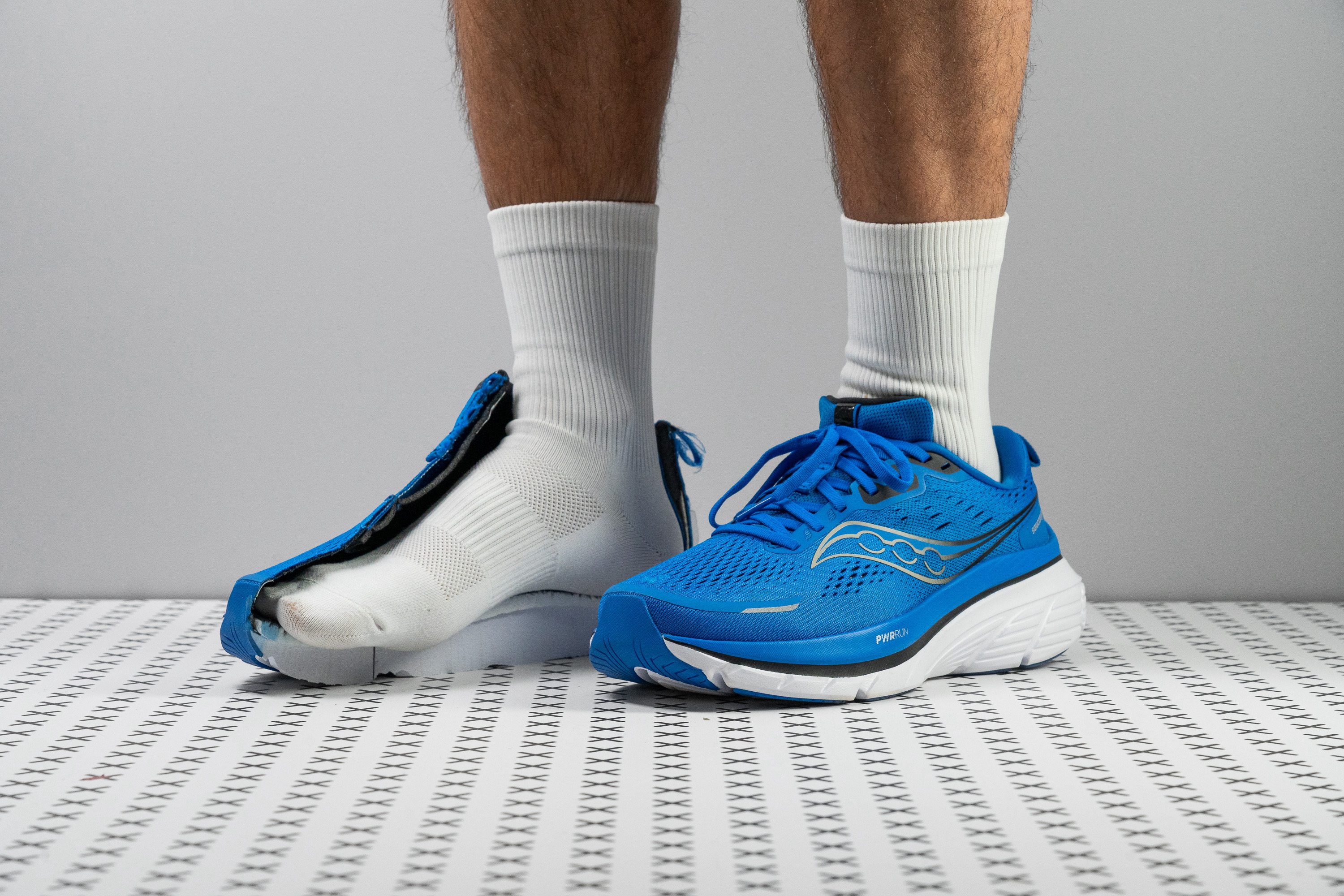Nuestra conclusión
Pros
- Upper muy transpirable
- Pisada estable pero sin ser restrictiva
- Amortiguación suficiente para carreras largas
- También sirven para caminar
- Plataforma muy ancha
- Plantilla PWRRUN PB
- Cierre seguro y cómodo
- Rocker del talón muy bien diseñado
Contras
- Suela exterior con demasiada espuma expuesta
- Se sienten voluminosas y poco ágiles
- La mediasuela es un poco firme
- La mediasuela es un poco firme
Veredicto de los usuarios
- Top 1% entre zapatillas de running Saucony Guide
- Top 16% más vendidas zapatillas de running
Comparativa
Las zapatillas de running más parecidas
+ + Añadir unas zapatillas | |||||
|---|---|---|---|---|---|
| Puntuación global | 80 Buenas | 80 Buenas | 85 Buenas | 78 Aceptables | |
| Precio | 150 € | 130 € | 160 € | 180 € | |
| Pace | Correr a diario | Correr a diario | Correr a diario | Correr a diario | |
| Arch support | Estabilidad | Estabilidad | Estabilidad | Estabilidad | |
| Peso laboratorio Peso marca | 9.8 oz / 278g 9.6 oz / 272g | 8.1 oz / 231g 8 oz / 228g | 10.4 oz / 295g 10.5 oz / 298g | 10.8 oz / 305g 10.7 oz / 303g | |
| Lightweight | ✗ | ✓ | ✗ | ✗ | |
| Drop laboratorio Drop marca | 8.3 mm 6.0 mm | 9.4 mm 5.0 mm | 9.3 mm 8.0 mm | 10.1 mm 10.0 mm | |
| Técnica de carrera | TalónMedio/antepié | TalónMedio/antepié | TalónMedio/antepié | Talón | |
| Talla | Tallan bien | Tallan un poquito pequeño | Tallan un poquito pequeño | Tallan bien | |
| Rigidez de la mediasuela | Equilibrada | Blanda | Blanda | Equilibrada | |
| Diferencia de la rigidez de la mediasuela en frío | Pequeña | Grande | Grande | Normal | |
| Durabilidad de la parte delantera | Buena | Mala | Decente | Decente | |
| Durabilidad del acolchado del talón | Media | Media | Baja | Alta | |
| Durabilidad de la suela exterior | Buena | Mala | Decente | Buena | |
| Transpirabilidad | Alta | Alta | Media | Alta | |
| Anchura / ajuste | Media | Estrecha | Media | Media | |
| Anchura de la parte delantera | Media | Estrecha | Media | Media | |
| Flexibilidad | Moderada | Moderada | Moderada | Moderada | |
| Rigidez torsional | Rígidas | Rígidas | Moderadas | Rígidas | |
| Rigidez del contrafuerte del talón | Flexible | Rígido | Rígido | Moderado | |
| Rocker | ✗ | ✓ | ✗ | ✗ | |
| Talón laboratorio Talón marca | 36.0 mm 35.0 mm | 36.0 mm 33.0 mm | 36.8 mm 38.0 mm | 37.8 mm 39.0 mm | |
| Antepié laboratorio Antepié marca | 27.7 mm 29.0 mm | 26.6 mm 28.0 mm | 27.5 mm 30.0 mm | 27.7 mm 29.0 mm | |
| Anchuras disponibles | EstándarAnchoExtra Ancho | EstándarAncho | EstrechoEstándarAnchoExtra Ancho | EstándarAnchoExtra Ancho | |
| Orthotic friendly | ✓ | ✓ | ✓ | ✓ | |
| Estación | VeranoTodas las estaciones | VeranoTodas las estaciones | Todas las estaciones | VeranoTodas las estaciones | |
| Removable insole | ✓ | ✓ | ✓ | ✓ | |
| Clasificación | #303 17% inferior | #302 17% inferior | #216 41% inferior | #322 12% inferior | |
| Popularidad | #57 Top 16% | #81 Top 23% | #35 Top 10% | #44 Top 12% |
Quién debería comprárselas
Las Saucony Guide 18 son una actualización sutil del modelo anterior que nos parece ideal para:
- Los corredores que quieren unas zapatillas estables a un precio razonable.
- Los que sienten que a las anteriores Guide les faltó transpirabilidad, ya que las 18 tienen un flujo de aire excelente.
- Las personas con pronación leve que buscan unas zapatillas de entrenamiento diario fiables con el toque justo de sujeción y un contrafuerte flexible.
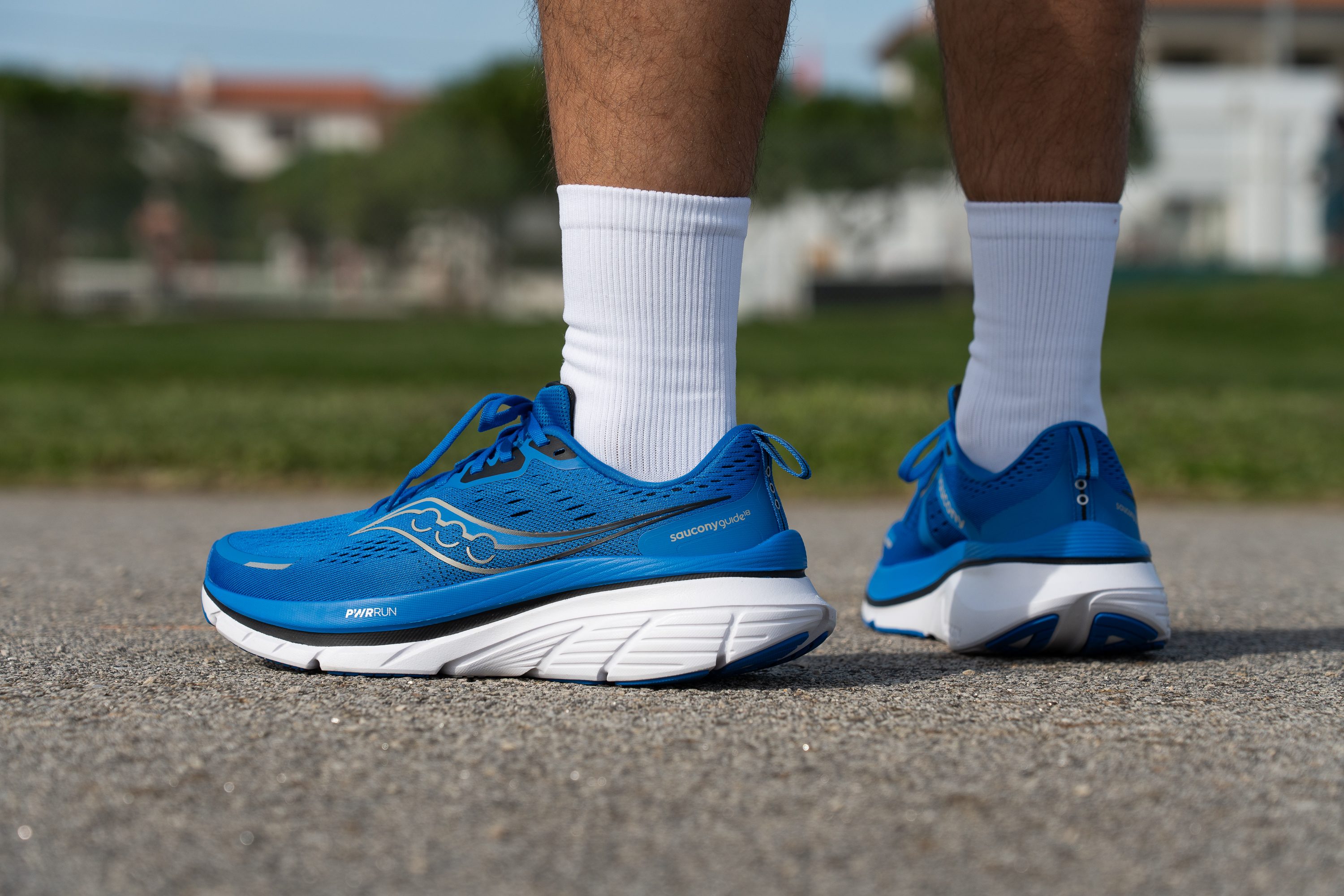
Quién NO debería comprárselas
Creemos que las Guide 18 no son la mejor opción para los corredores que quieren una pisada reactiva. La mediasuela PWRRUN carece de retorno de energía, por lo que sientes que es plana y que no tiene energía en comparación con las espumas modernas. Si estás buscando más rebote, te recomendamos que pruebes las ASICS Superblast 2.
Además, el diseño de la suela exterior deja demasiada espuma expuesta, lo que podría ser un problema de durabilidad para los corredores de metatarsos. Si la cobertura de caucho es una prioridad, las Brooks Glycerin GTS 21 nos parecen una opción mucho mejor, ya que su suela exterior ofrece mucha más protección, así como una experiencia llena de sujeción y amortiguación a un precio razonable.
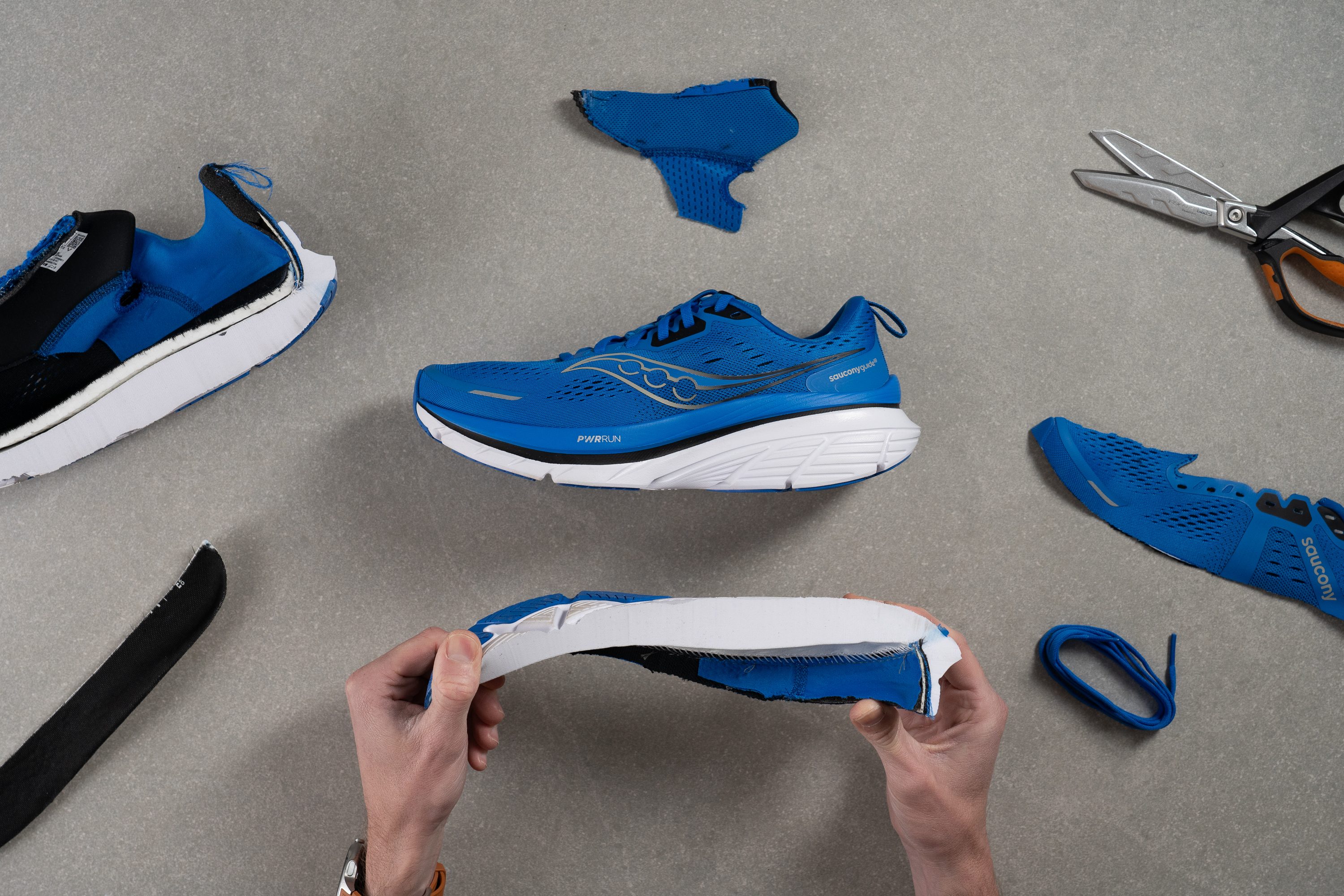
Amortiguación
Shock absorption
Aunque la mediasuela parece grandota, la absorción de impactos en el talón es estándar, de 124 SA. Por otro lado, el antepié se centra en ser cómodo alcanzando un resultado de 119 SA, por lo que es más mullido que el de la mayoría de sus competidoras dentro de la categoría de estabilidad.
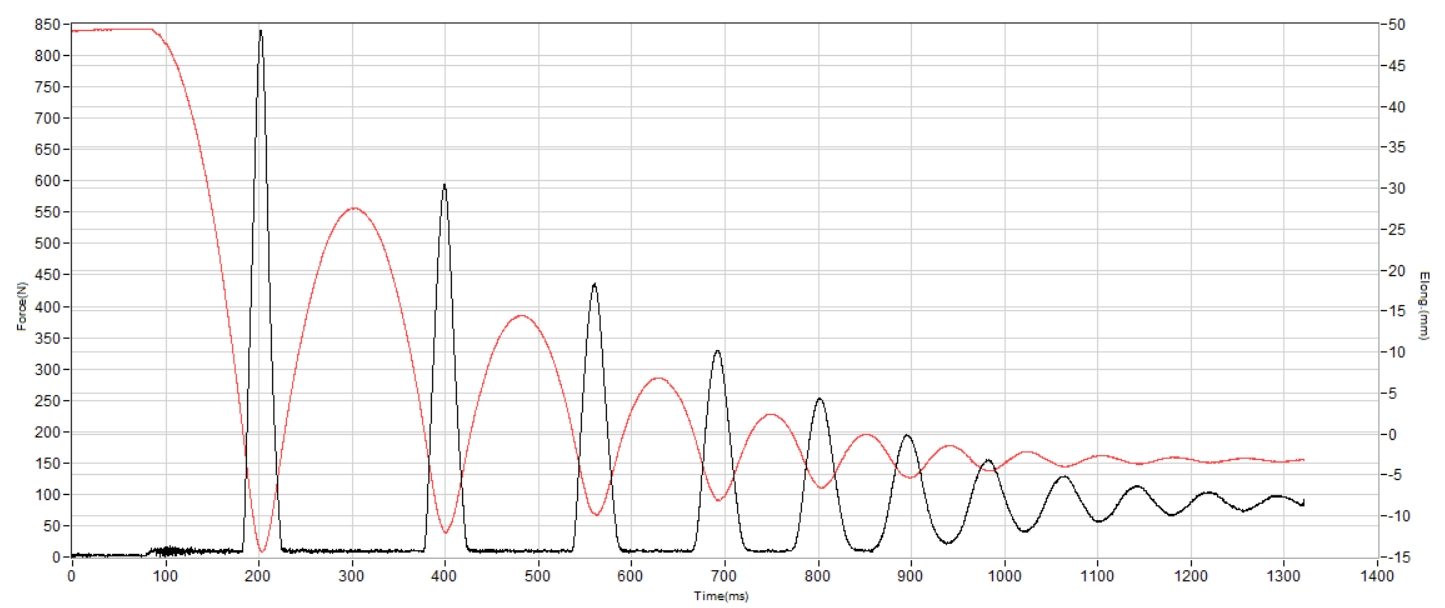
| Guide 18 | 124 SA |
| Media | 129 SA |
Energy return
Saucony actualizó sutilmente la mediasuela, y vimos que el retorno de energía del talón era un poquito mejor en comparación con el de las Guide 17. Ahora alcanza el 61,3 % y, aunque no son un Ferrari, no está mal para las carreras diarias.
| Guide 18 | 61.3% |
| Media | 58.6% |
Altura de la suela en la zona del talón
Las Saucony Guide 18 tienen 36,0 mm de amortiguación en el talón, y aunque antes eso las llevaría directamente a la categoría maximalista, ahora es una cifra estándar entre las zapatillas de entrenamiento diario. En nuestra opinión, ofrecen un equilibrio estupendo, ya que proporcionan mucha protección bajo los pies y consiguen que la pisada sea muy estable.
Esto también confirma lo poco que han cambiado con respecto al modelo del año pasado, ya que nuestras mediciones muestran un mínimo aumento de 1,1 mm con respecto a los 34,9 mm que registramos en 2024.
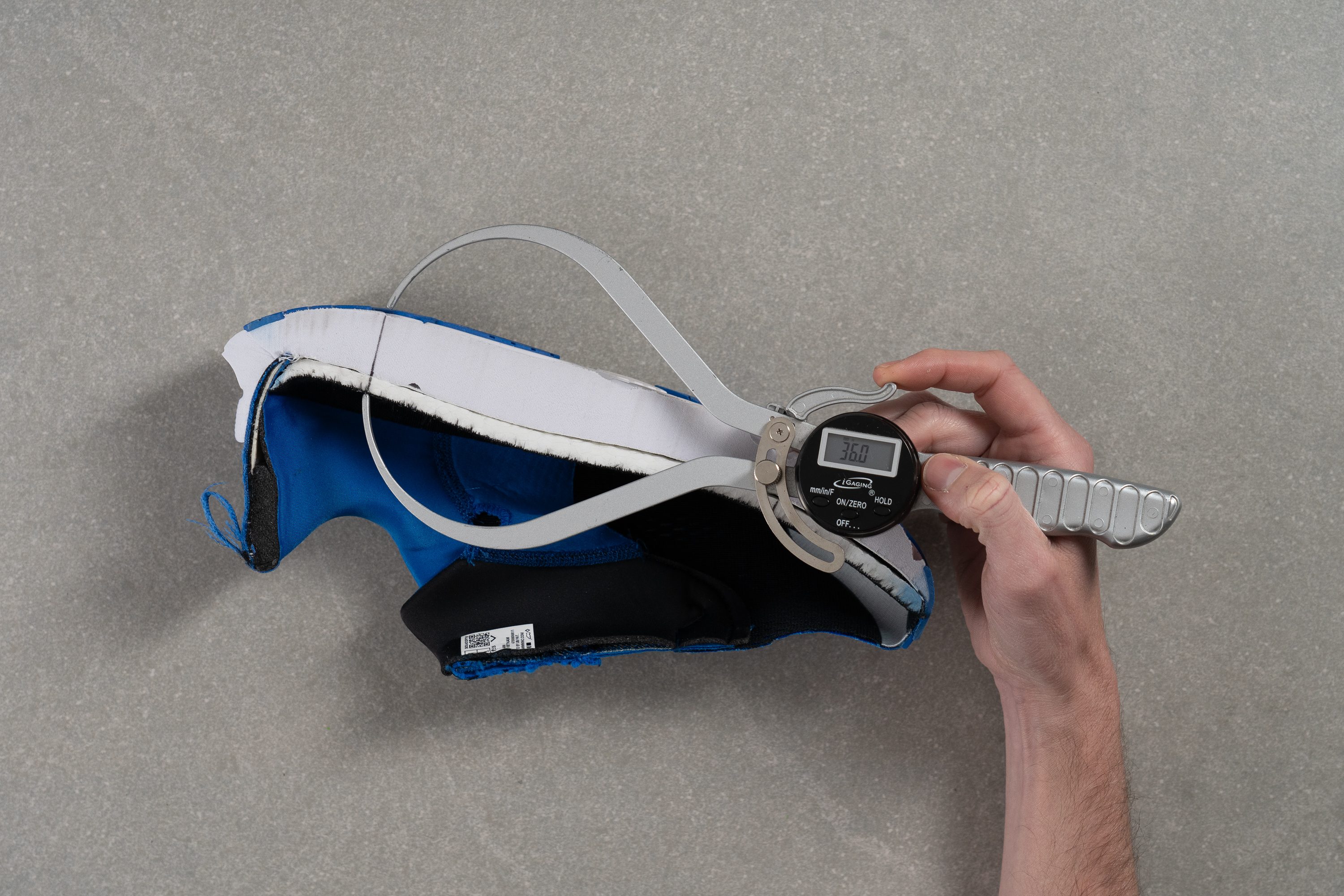
| Guide 18 | 36.0 mm |
| Media | 34.8 mm |
Altura de la suela en el antepié
El antepié también ofrece una generosa amortiguación de 27,7 mm, por lo que estas zapatillas son una buena opción para los corredores de metatarsos y de mediopié de cualquier altura y tamaño. ¡Incluso para las distancias largas!
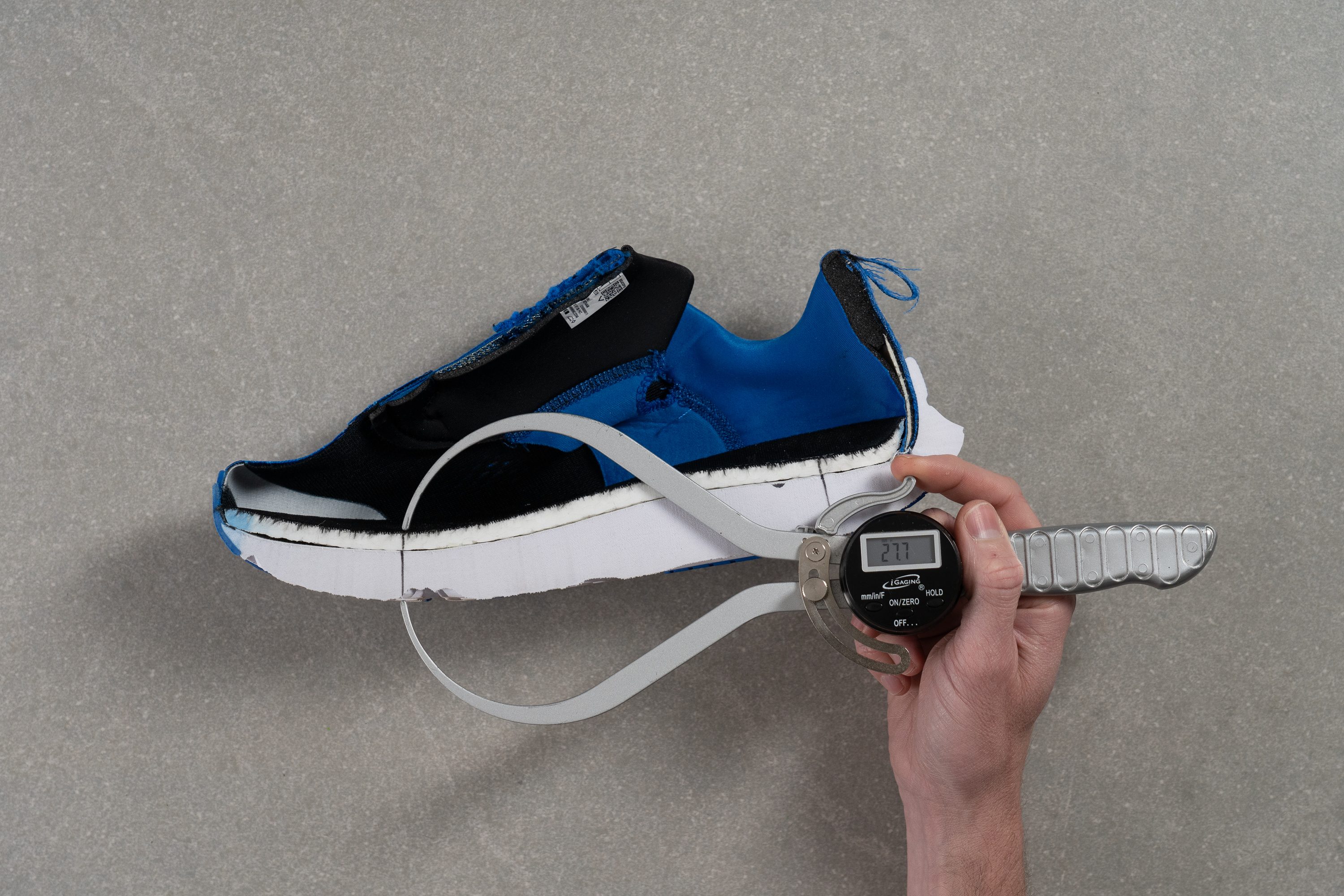
| Guide 18 | 27.7 mm |
| Media | 26.1 mm |
Drop
El drop de este modelo es bastante interesante. Oficialmente, Saucony dice que es de 6 mm, tanto en su web como en las especificaciones de producto, pero... cuando lo medimos nosotros, nos dio 8,3 mm. ¿Lo más curioso? Pues que la propia plantilla dice que el drop es de 8 mm, ¡mira!
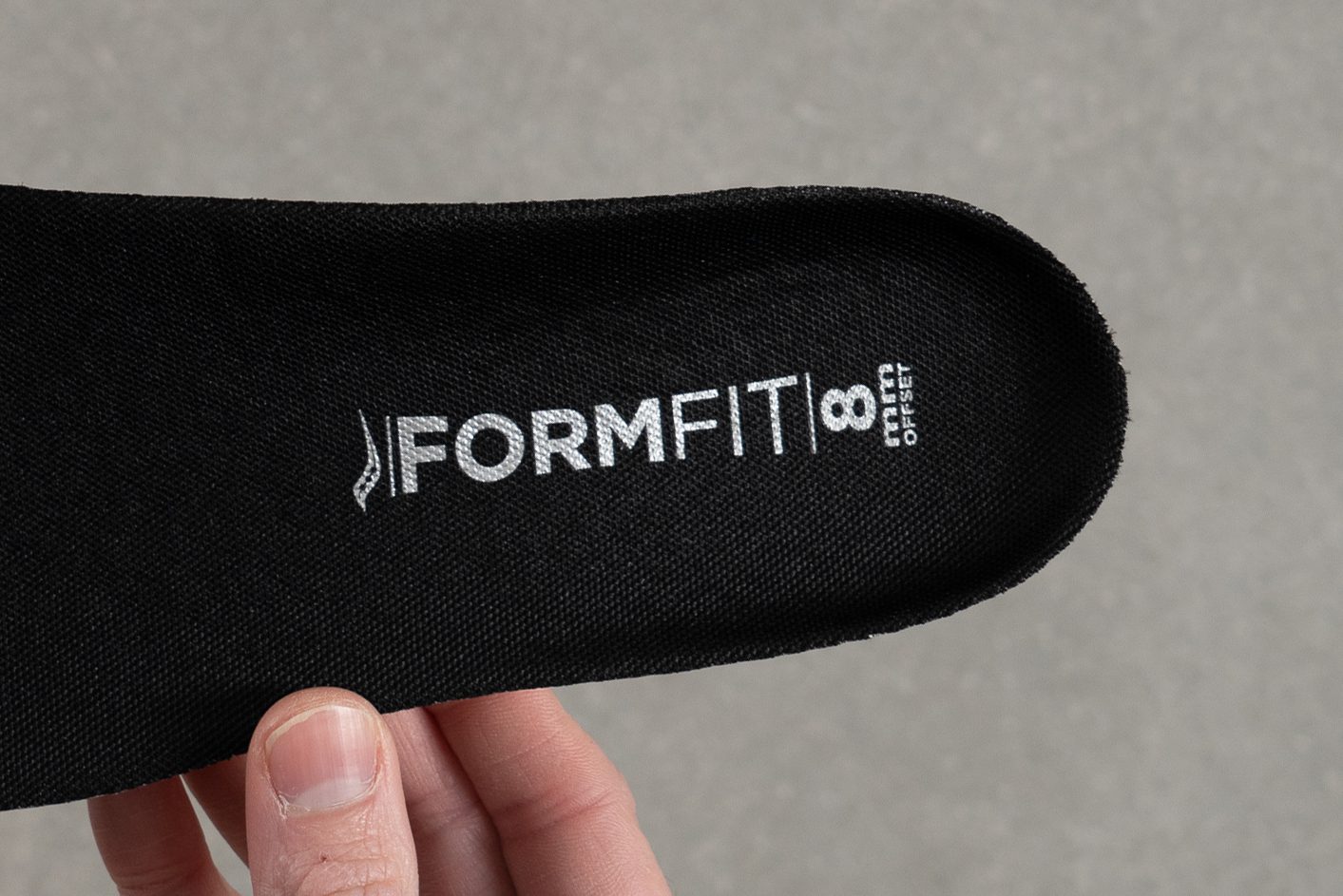
Hasta se lo preguntamos a un representante de Saucony, que se mantuvo firme diciendo que el drop era de 6 mm, incluso si la plantilla y nuestros resultados decían que no. En RunRepeat, medimos cada modelo en los puntos que indica la World Athletics, y a nosotros el drop nos dio 8,3 mm. Esto hace que las zapatillas sean adecuadas para los corredores de mediopié y los talonadores.
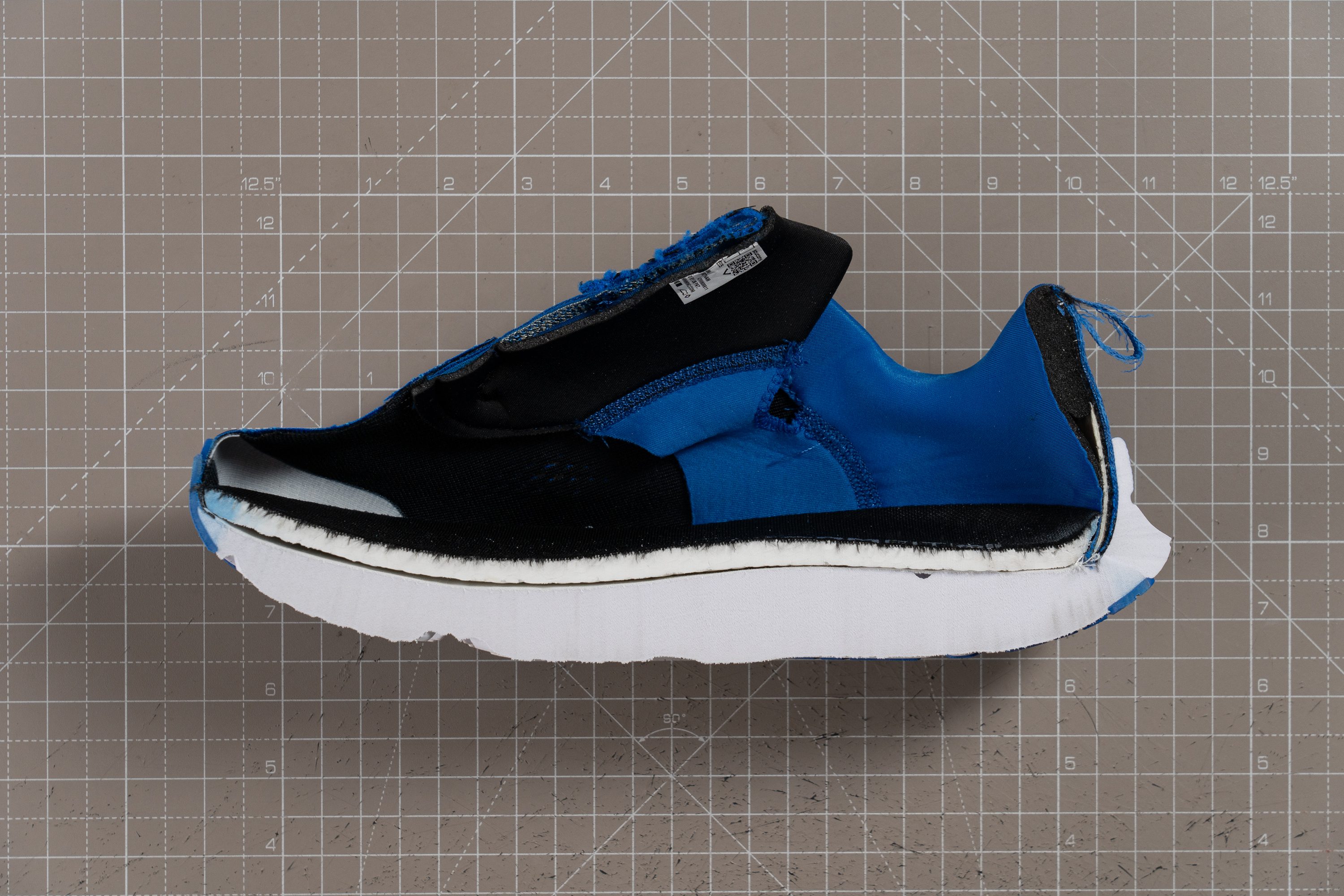
| Guide 18 | 8.3 mm |
| Media | 8.6 mm |
Suavidad de la mediasuela
Las Saucony Guide 18 tienen la misma mediasuela PWRRUN de EVA, que, en nuestra opinión, es lo que hace que estas zapatillas empiecen a quedarse atrás. Entendemos que la marca se guarde la mediasuela PWRRUN PB para los modelos premium, pero creemos que utilizar la PWRRUN+ habría sido una mejora ideal en este caso. Bueno, ¡tal vez para la v19!
De todos modos, esto no es un problema para los corredores que no se centran en el retorno de energía. La espuma ofrece lo que uno se espera de unas zapatillas de estabilidad suave, pero es más bien firme. Nuestro durómetro lo confirmó en el laboratorio al marcar 23,0 HA, reforzando así la sensación de estabilidad en la planta del pie.
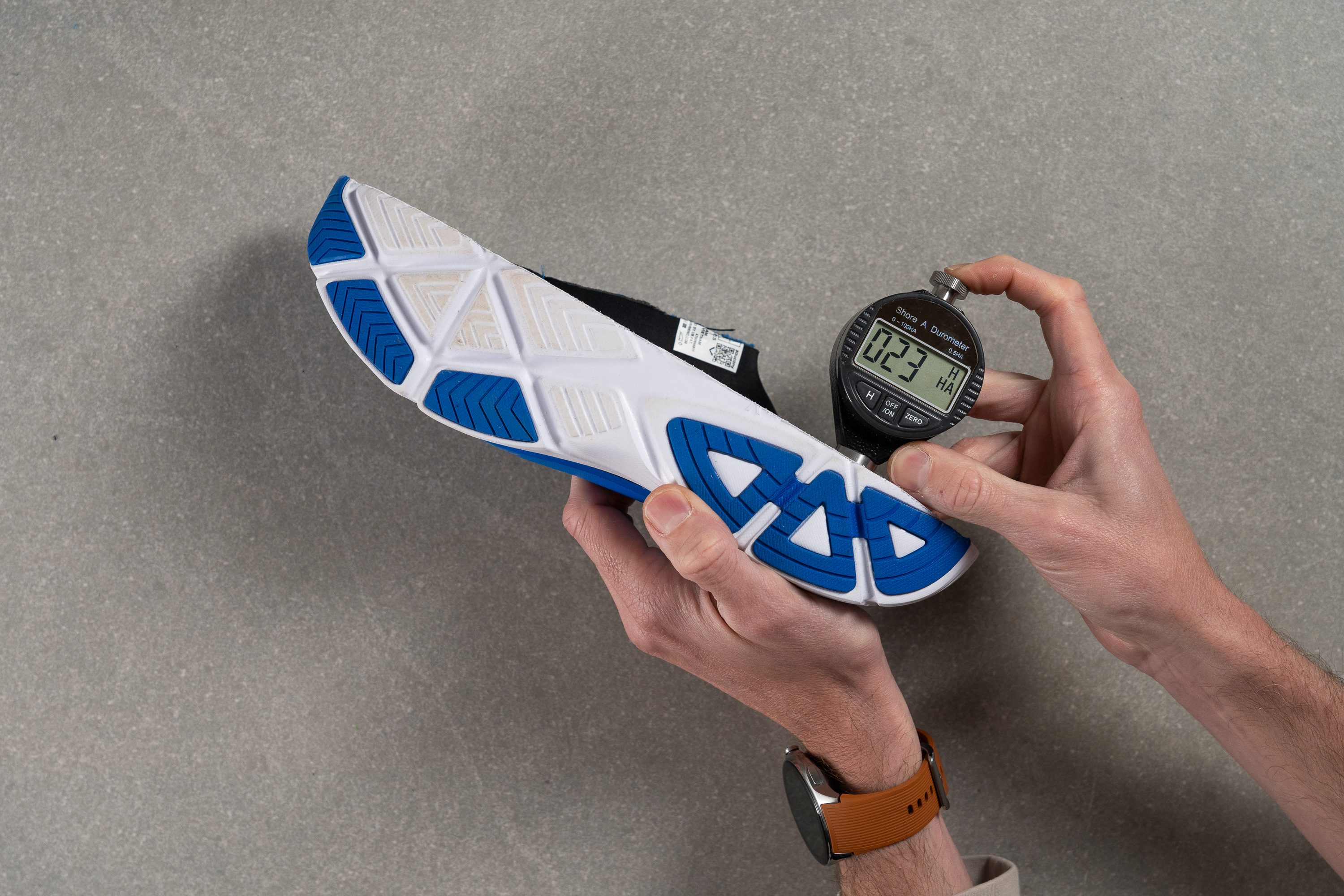
| Guide 18 | 23.0 HA |
| Media | 20.4 HA |
Rocker
Uno de los cambios más grandes que Saucony les ha hecho a las Guide en los últimos años es que su mediasuela ahora está más curvada, lo que ayuda a compensar la mayor altura de la suela de sus últimos diseños. Este ajuste sutil pero efectivo mejora las transiciones sin poner en riesgo la estabilidad.
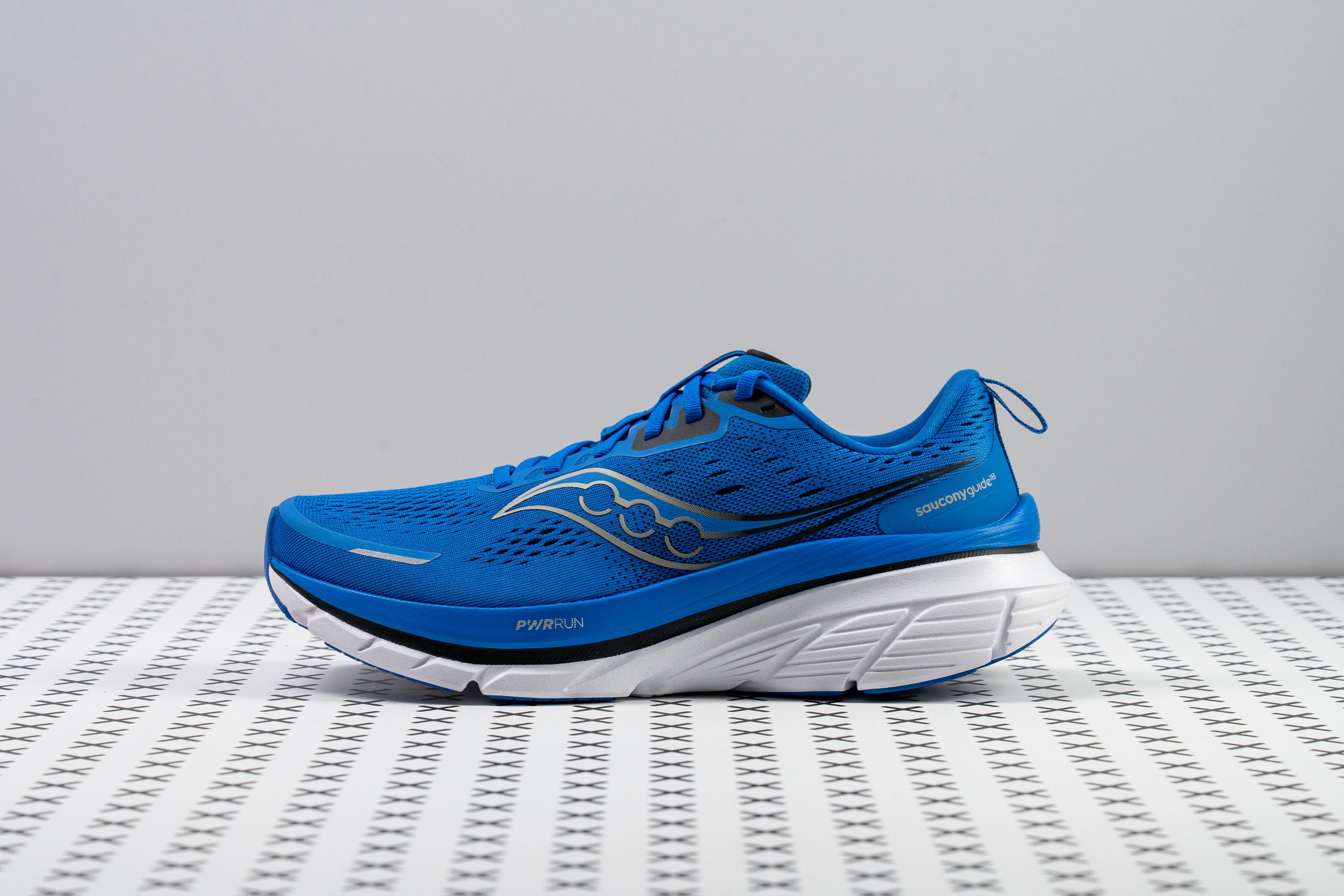
La curvatura del talón es bastante pronunciada, a lo que se le suma una extensión en esa misma zona que ayuda mucho a mejorar la sujeción para los talonadores, aunque a algunos les puede ser un poco extrema. El rocker del antepié es moderado, y ayuda a que la pisada sea más fluida y natural.
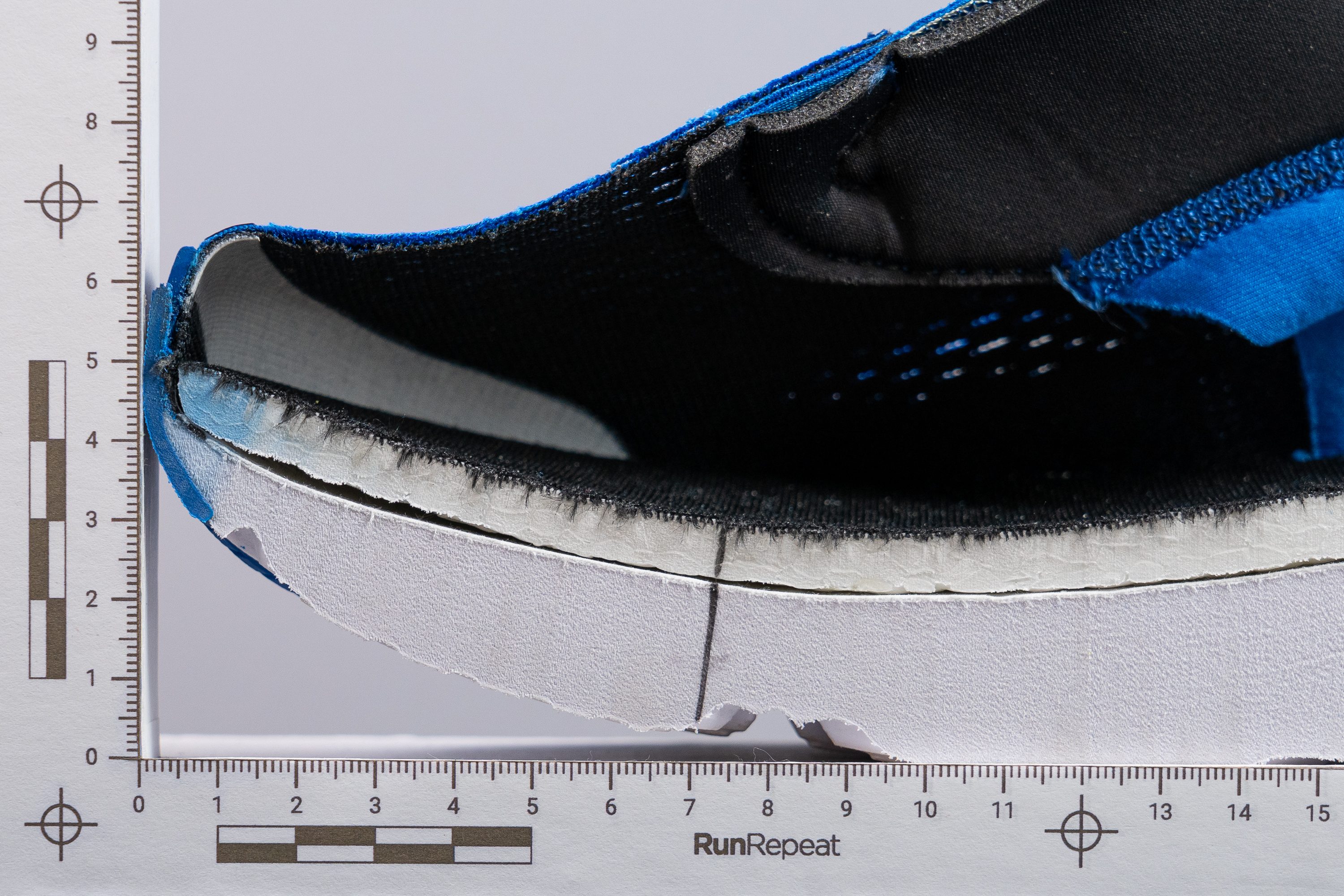
Tallaje y ajuste
Talla
Las Saucony Guide 18 tallan bien (66 votos).
Anchura / Ajuste
En el laboratorio, hicimos un molde de gel del interior de las Guide 18 y medimos su parte más ancha, que nosdio 96,3 mm. Esto hace que sean un poquito más anchas que la mayoría de las zapatillas de running, pero dentro de la media.
Estamos convencidos de que Saucony ha diseñado este modelo con un ajuste versátil en mente, ya que su objetivo es adaptarse a los pies de distintas formas sin hacer que las zapatillas sean demasiado estrechas o demasiado anchas.
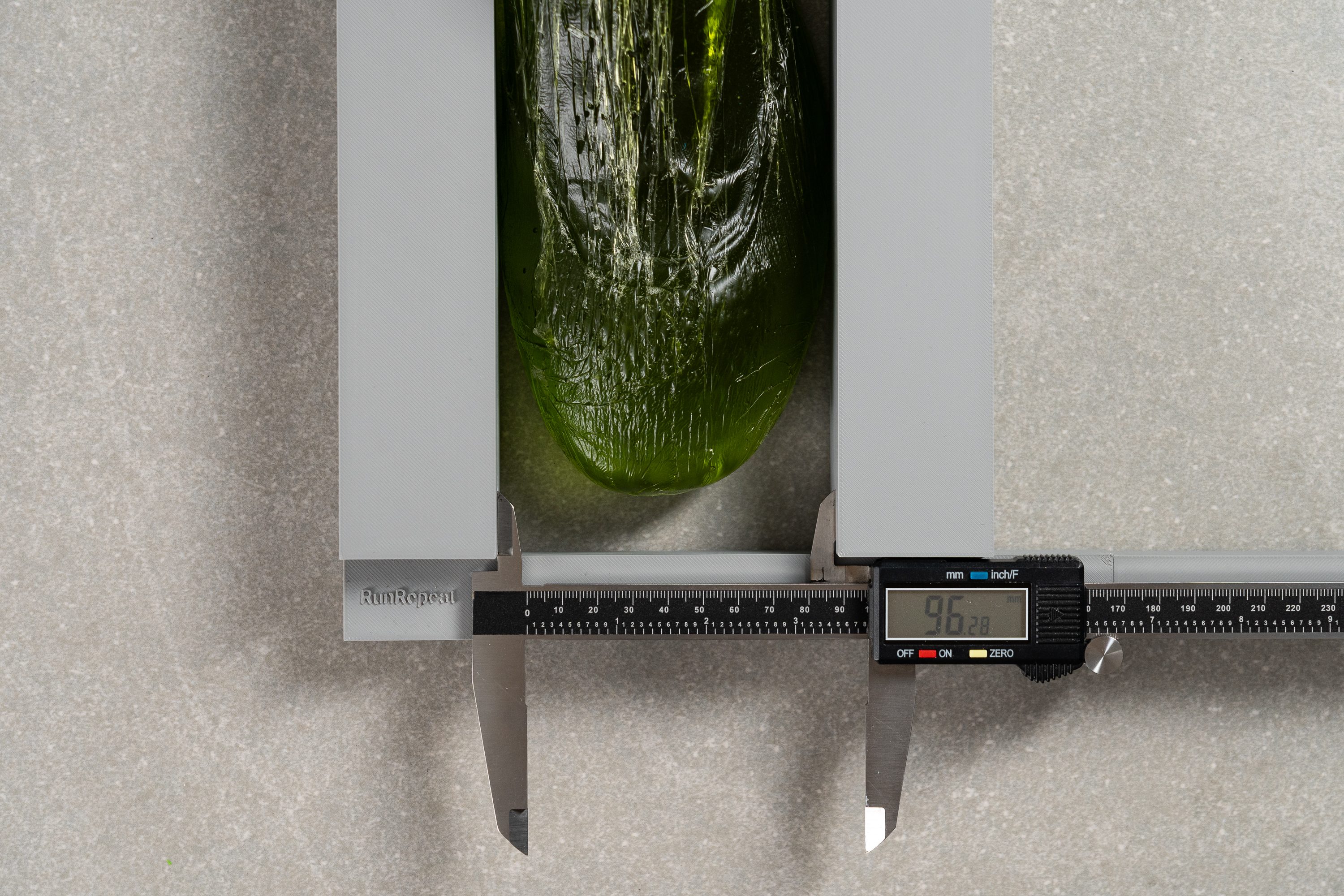
| Guide 18 | 96.3 mm |
| Media | 95.1 mm |
Anchura de la parte delantera
La zona del dedo gordo sigue el mismo enfoque, con 73,6 mm, así que tampoco se mueve de la media. Es cómoda, pero no ofrece mucho espacio para separar los dedos, que es algo que podría ser una limitación para los corredores que tienen los pies anchos.
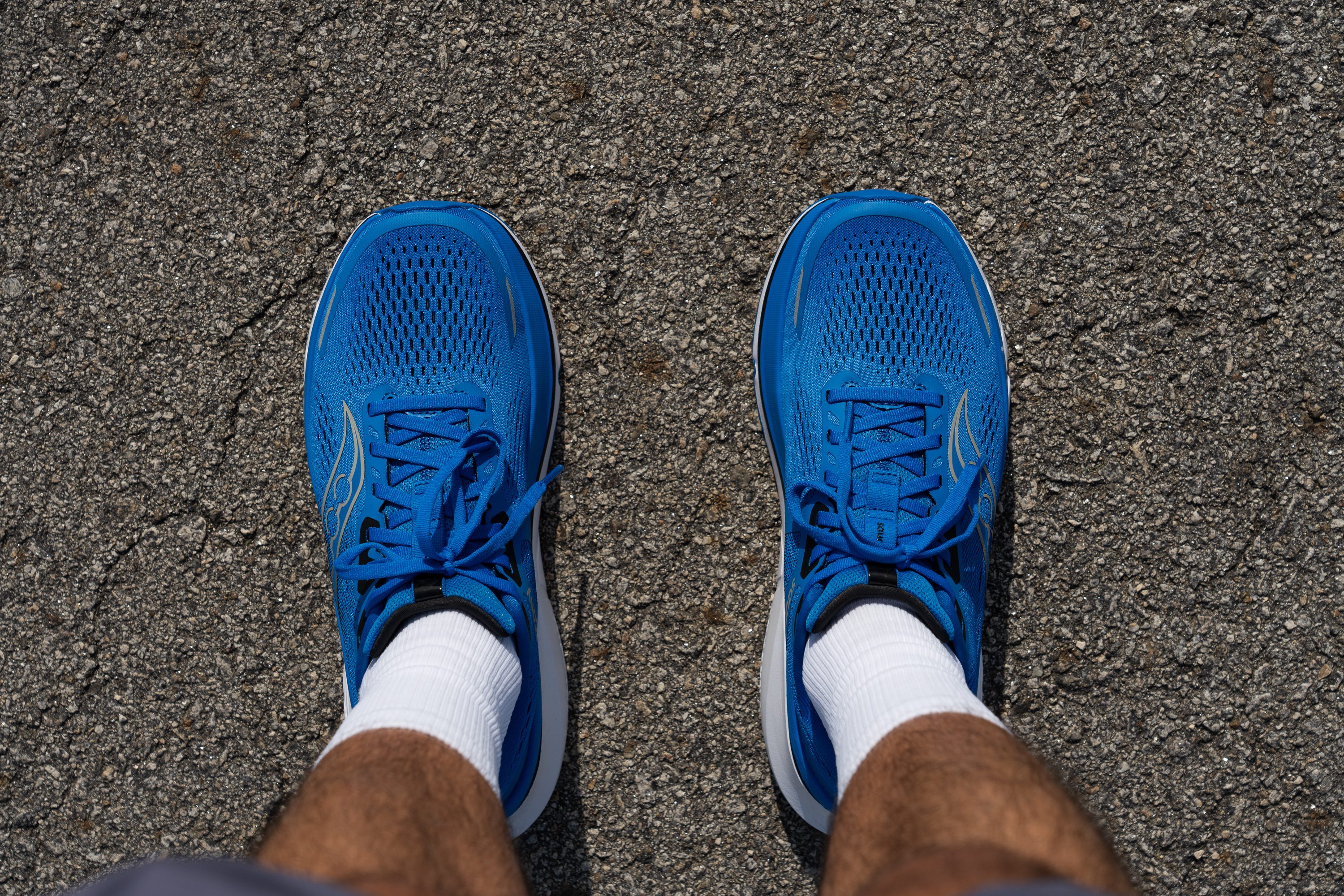
Eso sí, este es uno de los pocos modelos del mercado que está disponible en tallas estándar, anchas y extra anchas, así que se adapta a un montón de formas del pie distintas. Nosotros le hemos hecho pruebas a su versión estándar D.
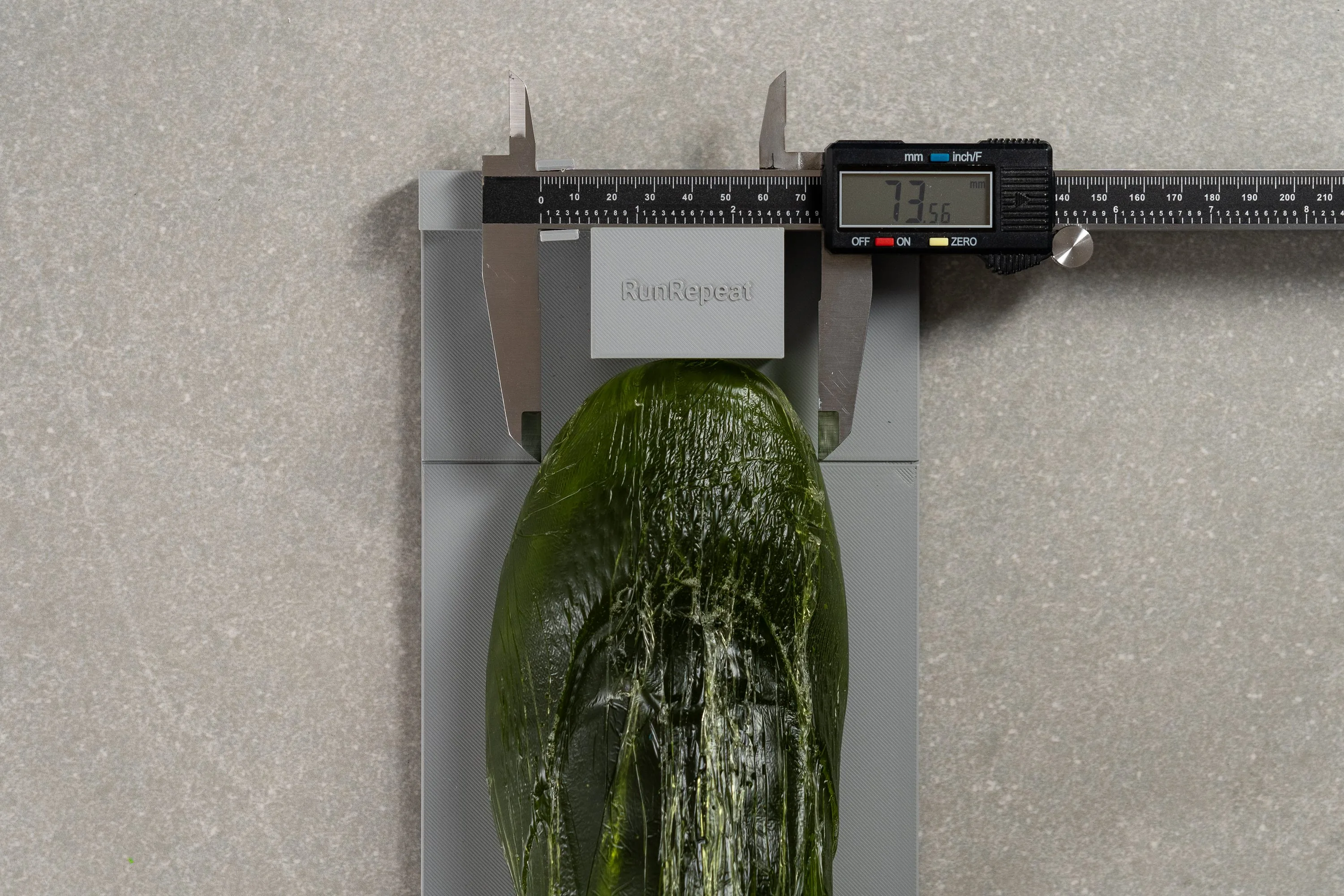
| Guide 18 | 73.6 mm |
| Media | 73.3 mm |
Altura de la parte delantera
Lo que sí que consiguió captar mucho nuestra atención es lo alta que es la parte delantera. Esto la hace perfecta para las personas que quieren más espacio vertical en la zona de los dedos.
Cuando la medimos, nos dio 34,3 mm, un aumento importante respecto a los 29,3 mm de sus predecesoras.
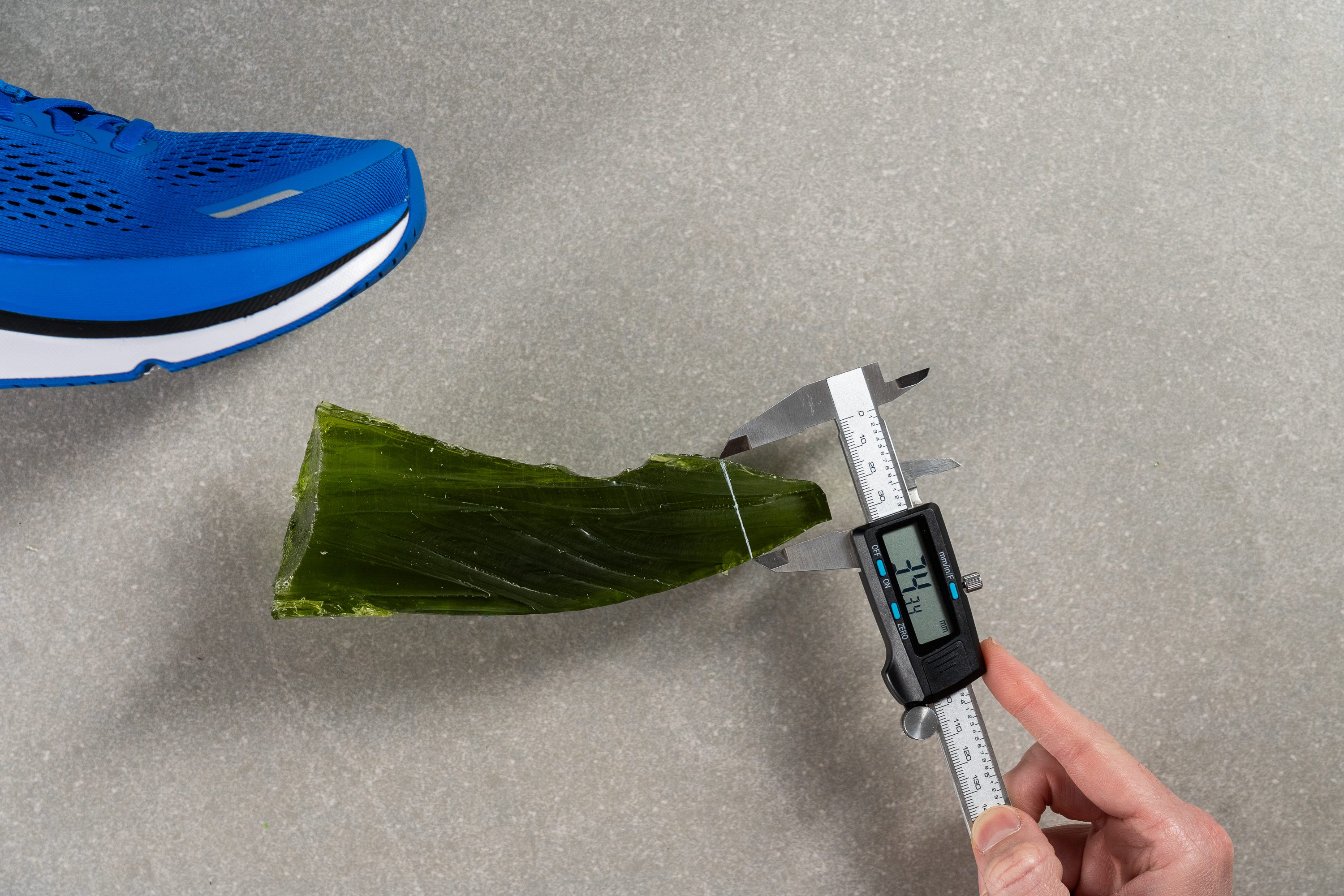
| Guide 18 | 34.3 mm |
| Media | 27.1 mm |
Tracción / Agarre
Traction test
Aunque tienen mucha espuma expuesta, Saucony ha conseguido que las Guide sigan teniendo un buen agarre, llegando hasta el punto de que la tracción es una de las características más destacadas de estas zapatillas incluso en curvas cerradas.
Esta versión 18 se llevó un 0,51 en nuestra prueba SATRA TM144, que es más que suficiente para apañárselas bien en el asfalto empapado por la lluvia y controlar sin problema las superficies secas.
| Guide 18 | 0.51 |
| Media | 0.47 |
Diseño de la suela exterior
El diseño de la suela exterior nos ha parecido un poco arriesgado para unas zapatillas de entrenamiento diario. Combina caucho azul XT-900 duradero (87,5 HC) en las zonas de mayor desgaste, pero deja demasiada espuma expuesta.
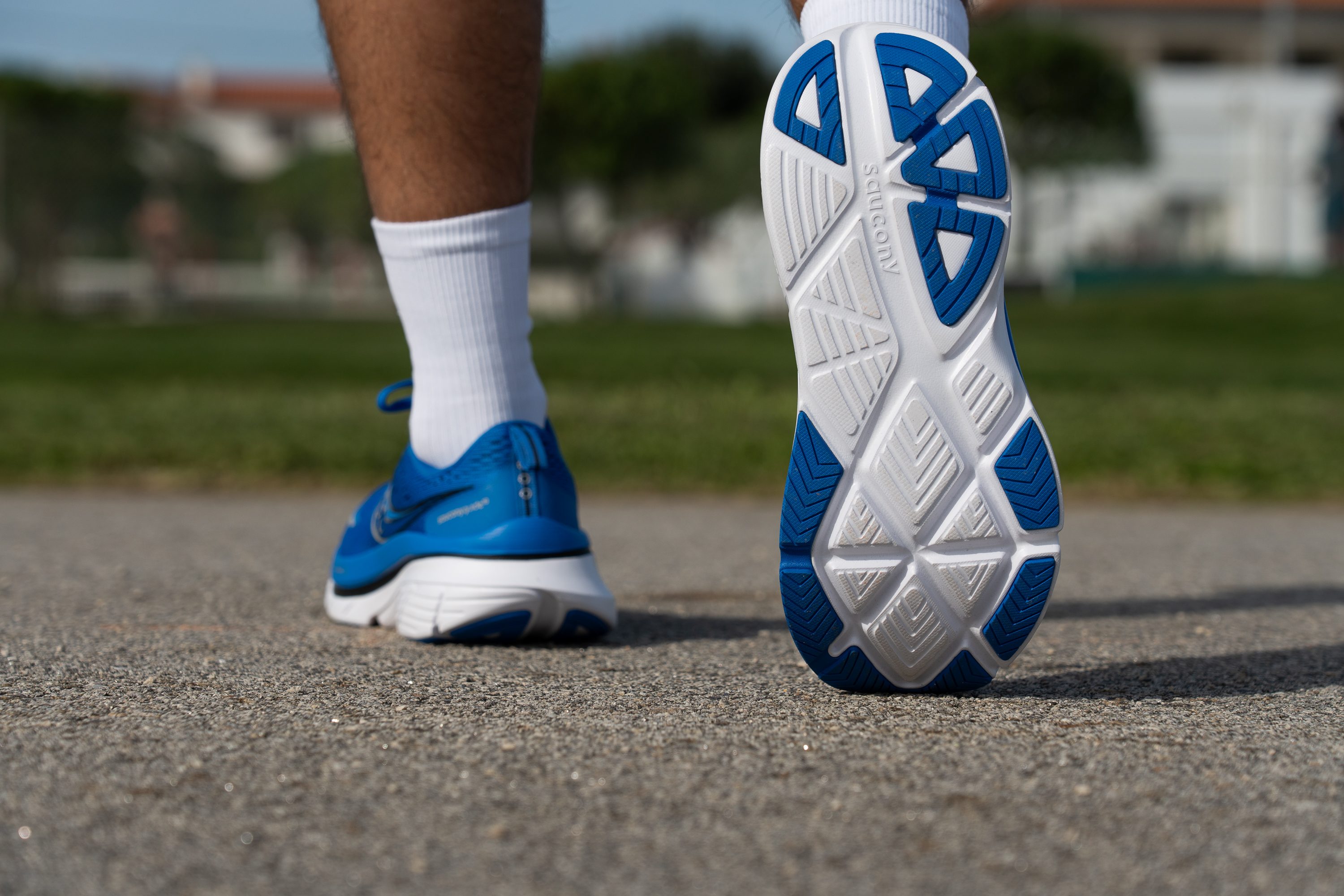
Flexibilidad / Rigidez
Aunque son unas gigantonas, estas zapatillas no son muy rígidas, ya que en nuestra prueba de flexibilidad necesitaron 13,2 N para doblarse. Nos parece una ventaja, ya que esto las hace más cómodas en los ritmos suaves y para caminar, dándoles la versatilidad que tanto necesitaban.
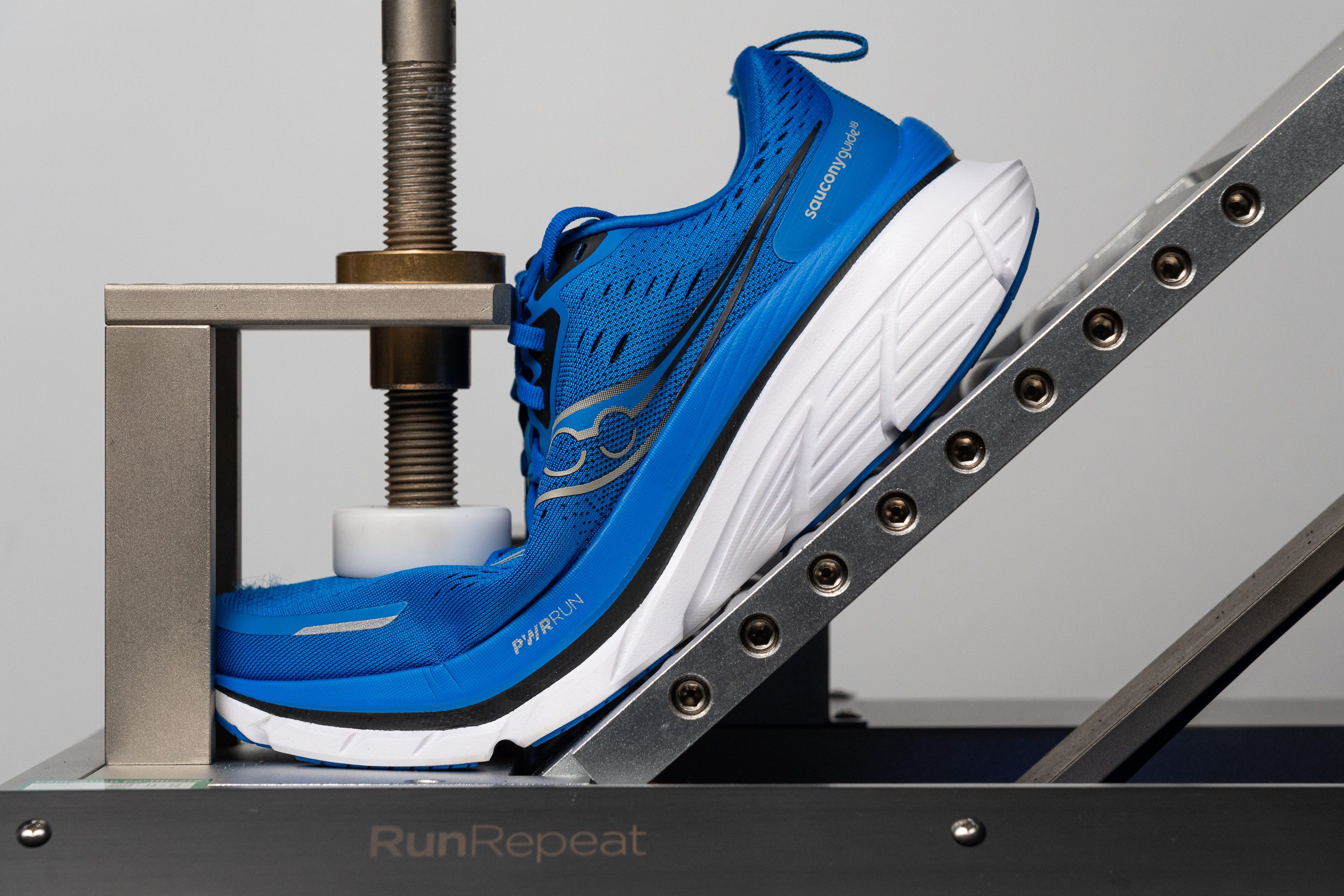
| Guide 18 | 13.2N |
| Media | 15.2N |
Peso
El modelo del año pasado pesa casi lo mismo (278 g) que este, con una diferencia de solo 3 g. Como esto puede ser una desviación propia del proceso de fabricación, para nosotros el peso no ha cambiado.
Al igual que el resto de las zapatillas, el peso es normal: ni tan ligeras como para llenarlas de halagos, ni tan pesadas como para quejarnos.
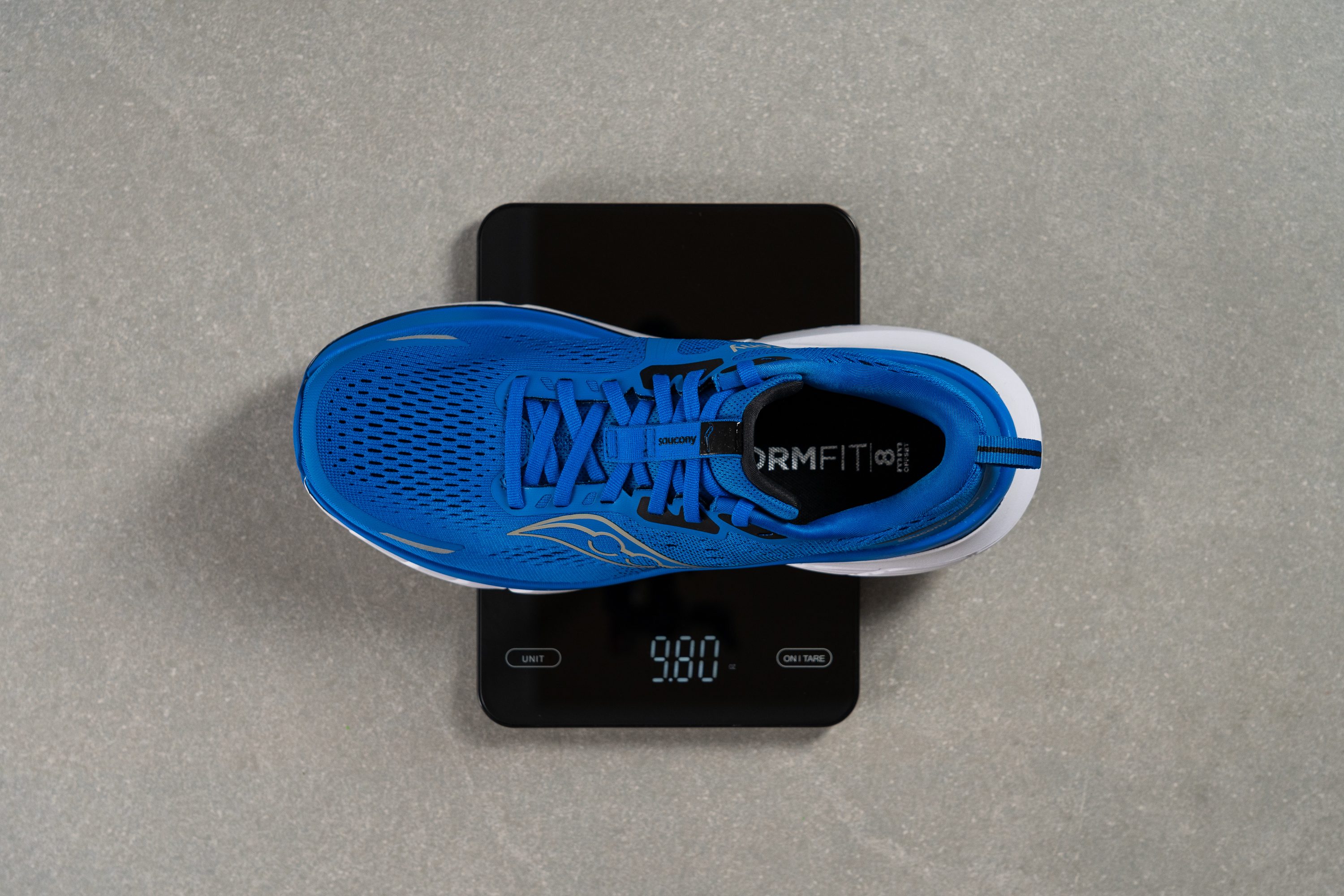
| Guide 18 | 9.8 oz (278g) |
| Media | 9.3 oz (265g) |
Transpirabilidad
Lo primero que nos llamó la atención cuando vimos estas zapatillas fueron los enormes agujeros para el flujo de aire de su parte delantera.
Después de analizar su transpirabilidad en el laboratorio, nos quedó claro que no se merecían menos que un perfecto 5/5. Las perforaciones gigantescas hacen que sean una opción excelente para los corredores cuyos pies se recalientan muy rápido, o para cualquiera que quiera salir a correr cuando hace calor en verano.
También nos hemos dado cuenta de que Saucony ha añadido algunos agujeritos en la parte de atrás de las zapatillas. Eso sí, cuando las analizamos utilizando una luz, nos dimos cuenta de que eran solo estéticas. Lo bueno es que el lateral de la parte delantera sigue ofreciendo un buen flujo de aire, que es algo que no vemos en todas las zapatillas.
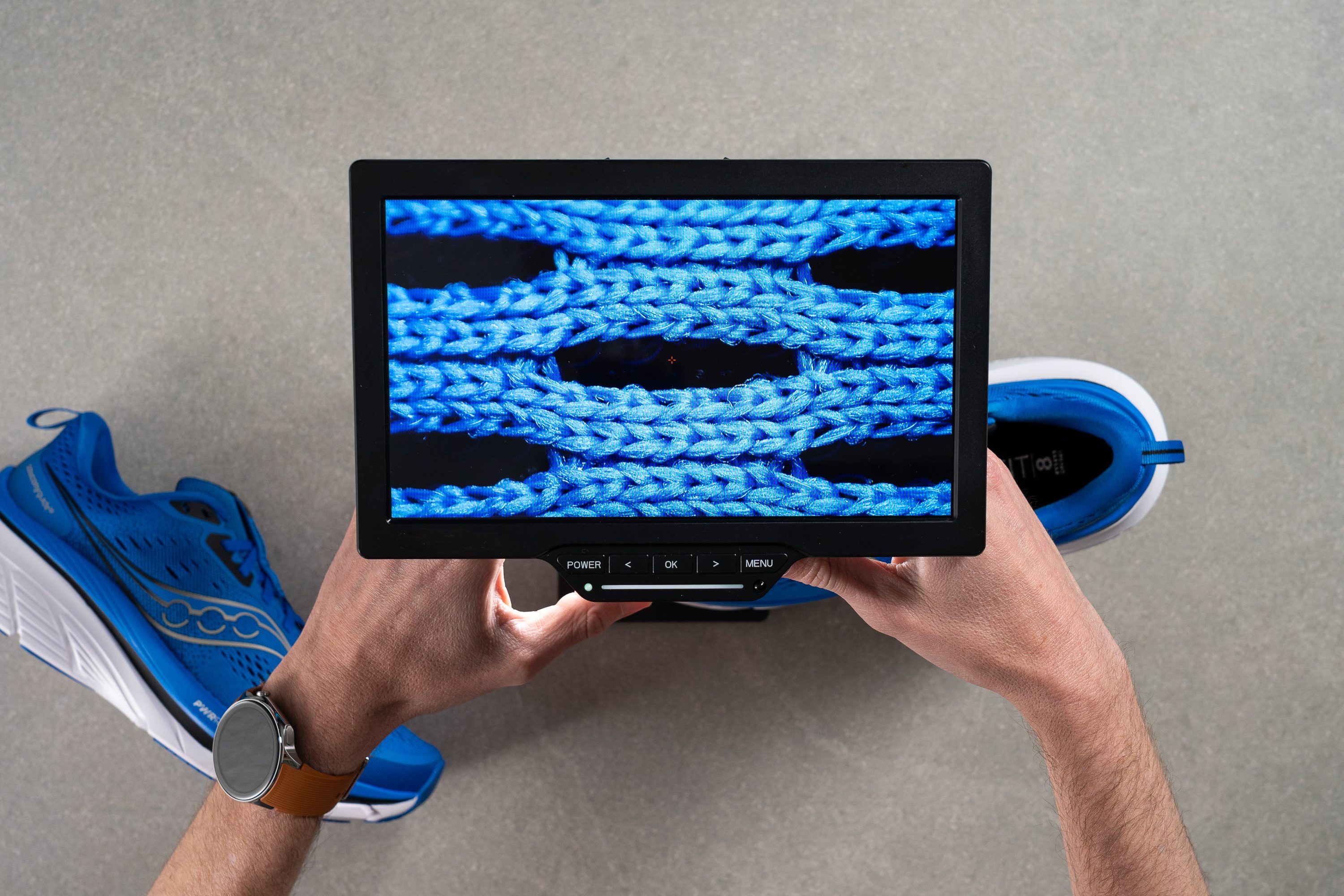
Para saber ver más, utilizamos nuestro microscopio digital.
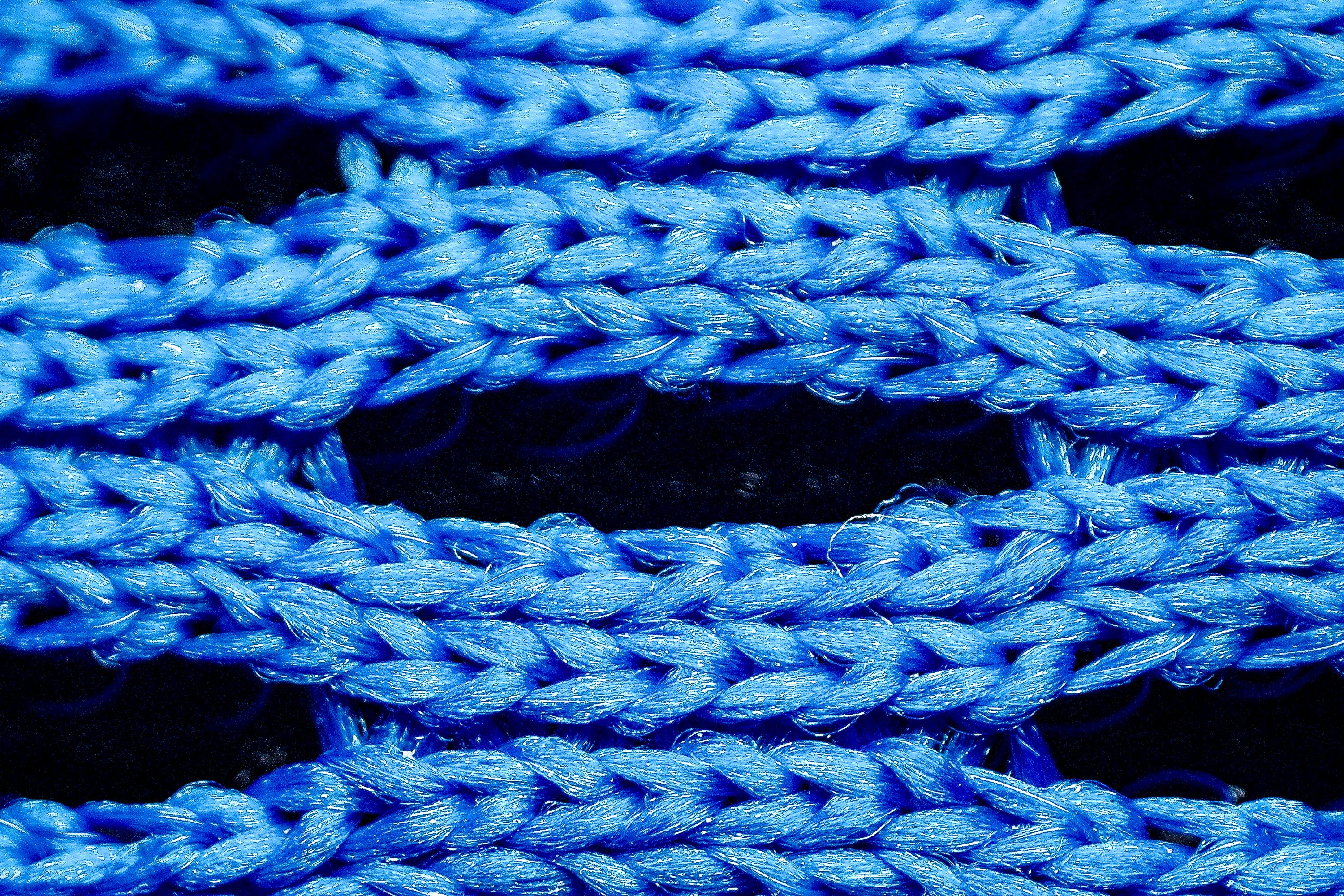
Los resultados fueron impresionantes: este modelo es de los que menos espacio deja entre un agujerito y otro. Al final, cuanto más espacio haya, más fácil (y barato) es el diseño del upper.
En nuestra opinión, el upper ofrece un buen equilibrio entre transpirabilidad y acolchado. La zona del talón está muy bien amortiguada con espuma blanda, pero no te esperes una sensación comodísima tampoco, ya que este modelo prioriza el flujo de aire, y todo lo demás va detrás.
| Guide 18 | 5 |
| Media | 3.7 |
Estabilidad
Prueba de estabilidad lateral
Este modelo está entre las zapatillas de entrenamiento diario neutras y las que son muy estables, por lo que es una opción versátil para muchos corredores distintos. Los corredores neutros no sentirán que les aprieta, mientras que los que tienen bastante pronación pueden añadir estas Saucony a su rotación si quieren un poco de sujeción extra.
Las paredes laterales de su mediasuela no están nada mal, la espuma es relativamente flexible y la base de aterrizaje es muy ancha, así que proporciona estabilidad y guía cada paso. En nuestra experiencia en las pruebas de uso, este diseño funciona muy bien.
Rigidez torsional
Un cambio importante con respecto a la v17 es el aumento de la rigidez torsional, ya que se han llevado un 4/5 en vez de un 3/5.
¿Que qué significa esto? Pues que los corredores que estén buscando algo más flexible, como la sensación de unas zapatillas de entrenamiento diario, a lo mejor no están del todo contentos con esto. Eso sí, como zapatillas de estabilidad, este ajuste mejora mucho la sujeción.
| Guide 18 | 4 |
| Media | 3.5 |
Rigidez del contrafuerte del talón
Lo que sí que nos sorprendió es que el contrafuerte del talón fuese relativamente flexible, ya que se llevó un 2/5 en esta prueba. Es algo poco común para las zapatillas de estabilidad, pero los corredores que tienen un tendón de Aquiles sensible o la deformidad de Haglund estarán encantados con las Guide 18.
| Guide 18 | 2 |
| Media | 2.9 |
Anchura de la mediasuela - antepié
Las Guide 18, al igual que el año pasado, son muy anchas. Nos hemos dado cuenta de que las marcas están utilizando este enfoque tan ancho en sus zapatillas de estabilidad, y cuando nuestro calibre marcó 121,9 mm en el antepié lo confirmamos.
En nuestra opinión, esta decisión es lógica: una plataforma más amplia mejora la sujeción y el equilibrio.
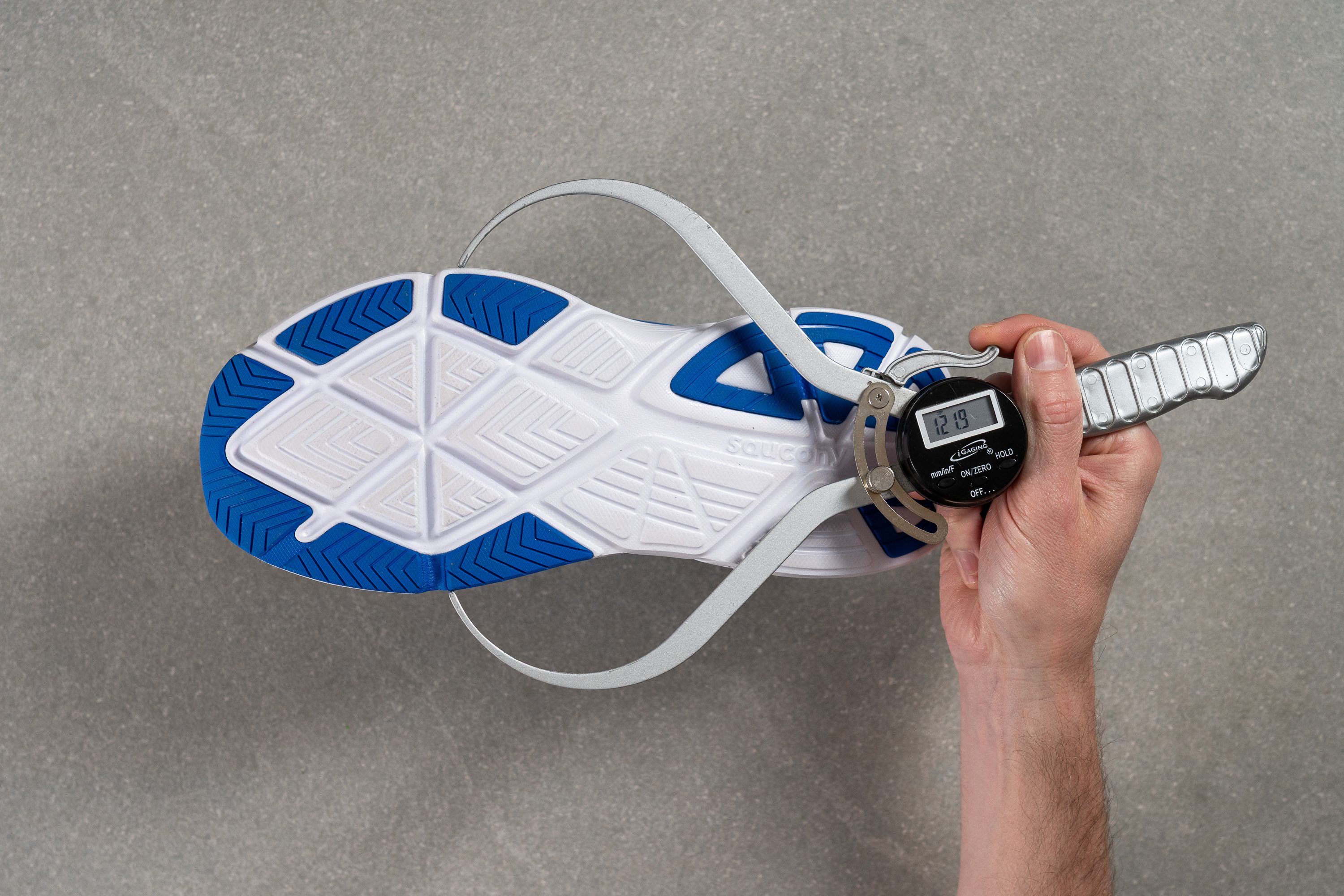
| Guide 18 | 121.9 mm |
| Media | 114.3 mm |
Anchura de la mediasuela - talón
Sin embargo, este enfoque tiene sus inconvenientes, y el más grande de todos nos parece el hecho de que las zapatillas se sientan toscas al correr.
Por desgracia, este podría ser el caso de las Guide 18, que tienen un talón gigante de 105,0 mm. Si estás buscando un equilibrio entre estabilidad y agilidad, las Nike Structure 25 pueden ser una mejor opción.
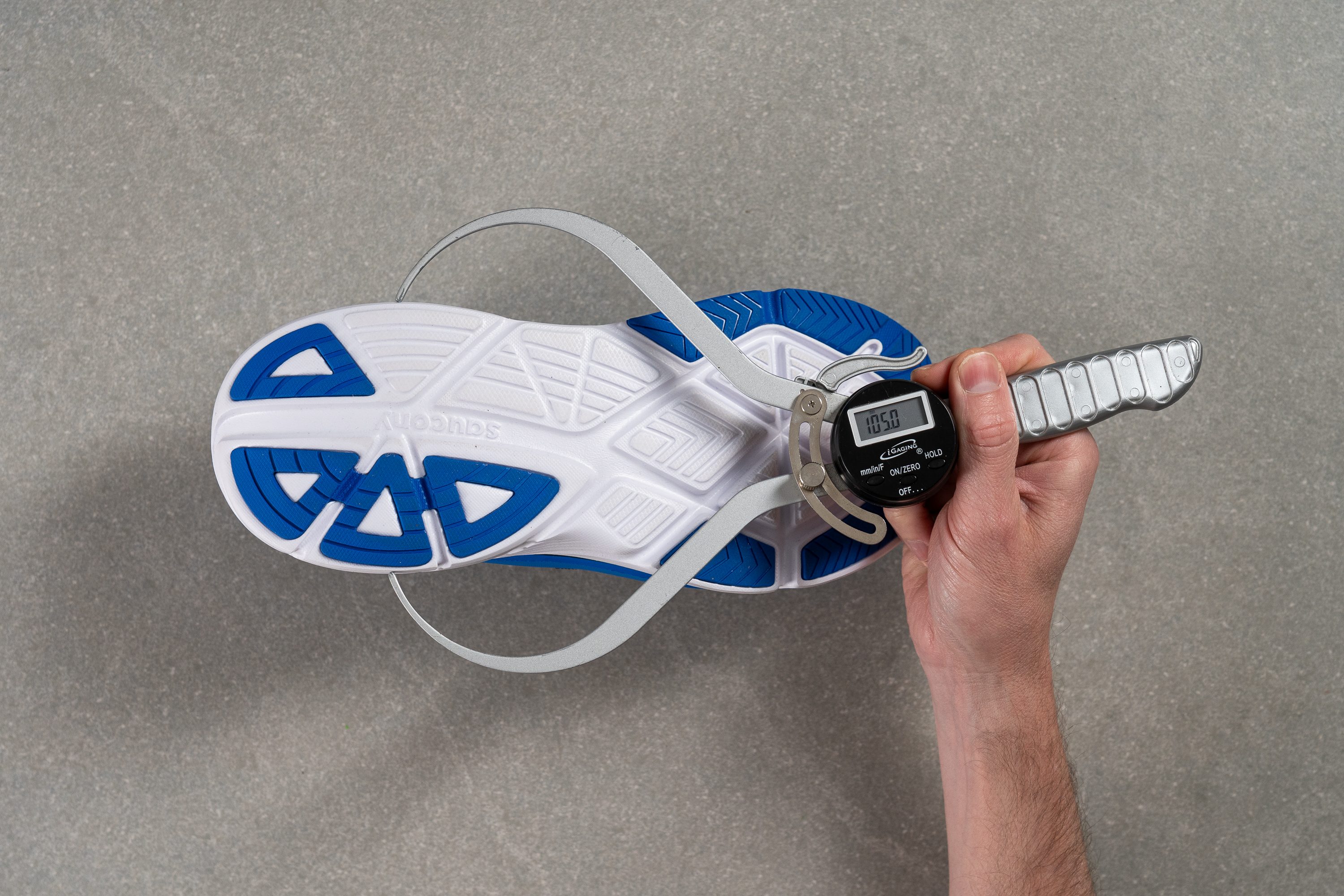
| Guide 18 | 105.0 mm |
| Media | 90.7 mm |
Durabilidad
Durabilidad de la parte delantera
Los uppers de malla con agujeros grandes para el flujo de aire suelen pasarlo mal en esta prueba, pero las Guide 18 nos dieron una sorpresa maravillosa.
Aunque un 4/5 no es la puntuación más alta, nos parece que es bastante impresionante teniendo en cuenta el diseño de la parte delantera, que se centra en mejorar la transpirabilidad.
| Guide 18 | 4 |
| Media | 2.6 |
Durabilidad del acolchado del talón
Es una pena, pero el acolchado del talón se queda corto en durabilidad si lo comparamos con la zona de los dedos. La verdad es que esto sí que nos pilló por sorpresa, ya que normalmente vemos todo lo contrario. Se llevó un 2/5 en esta prueba, así que está bastante lejos de ser ideal.
| Guide 18 | 2 |
| Media | 3.4 |
Durabilidad de la suela
El caucho XT-900 es muy resistente al desgaste, ya que terminó con unos daños de solo 0,6 mm en nuestra prueba con el Dremel.
| Guide 18 | 0.6 mm |
| Media | 1.1 mm |
Grosor de la suela
El grosor de la suela exterior está por encima de la media, con 3,4 mm, aliviando eficazmente nuestras preocupaciones por el desgaste prematuro. Eso sí, si sueles desgastar las zonas que no están cubiertas por el caucho azul, este grosor extra no te servirá para mucho.
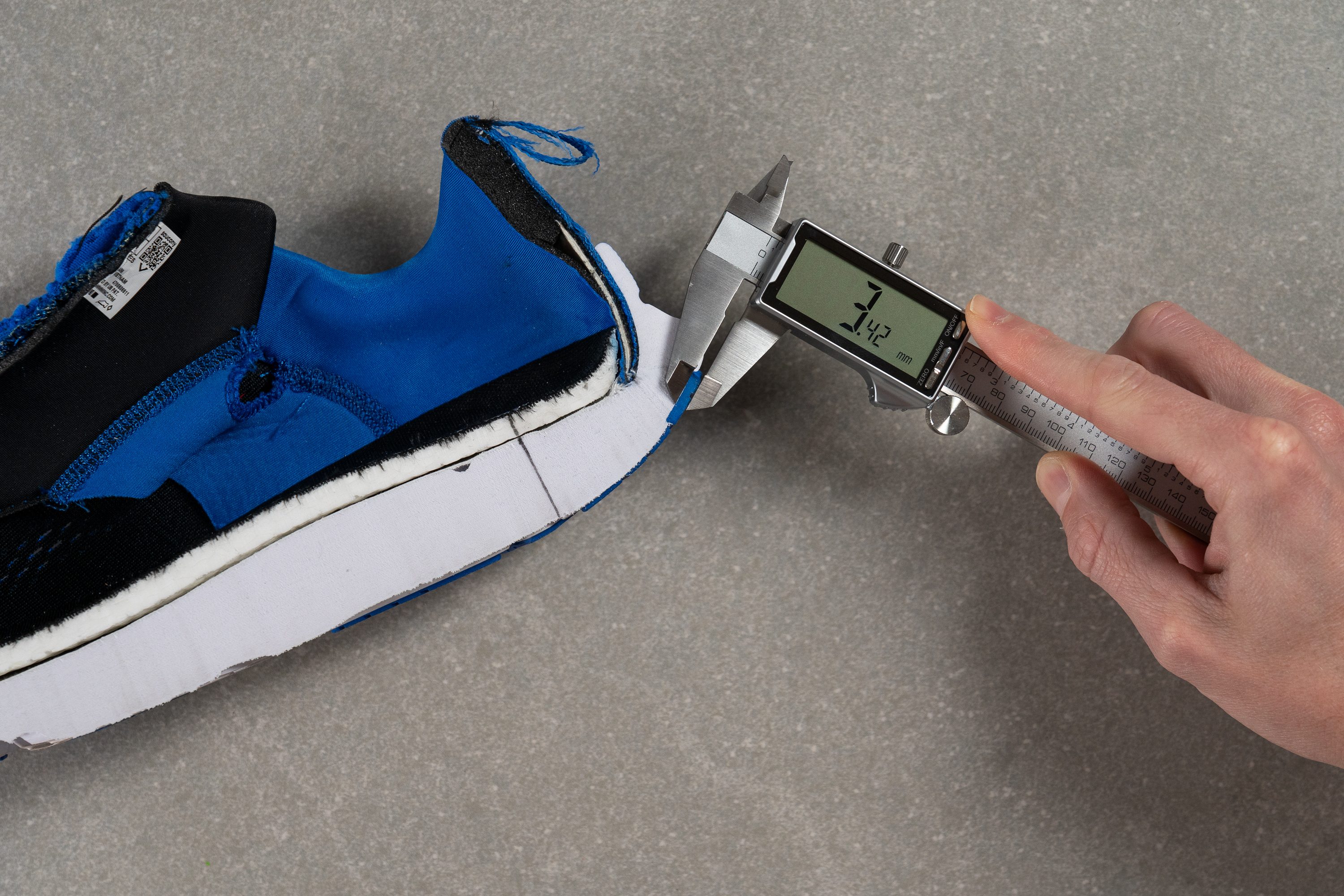
| Guide 18 | 3.4 mm |
| Media | 3.2 mm |
Varios
Grosor de la plantilla
La mediasuela PWRRUN se siente firme y no tiene nada de energía, pero la plantilla de 6,1 mm de grosor le echa una mano. Como está fabricada con PWRRUN PB, que es la misma espuma de Pebax que vemos en los modelos de gama alta de Saucony, como las Endorphin Speed 4, le da un toque de reactividad a la pisada.
Si Saucony le hubiese dado la vuelta a la tortilla y hubiera utilizando PWRRUN para la plantilla y PWRRUN PB para la mediasuela, ¡estas zapatillas podrían haber sido increíbles!
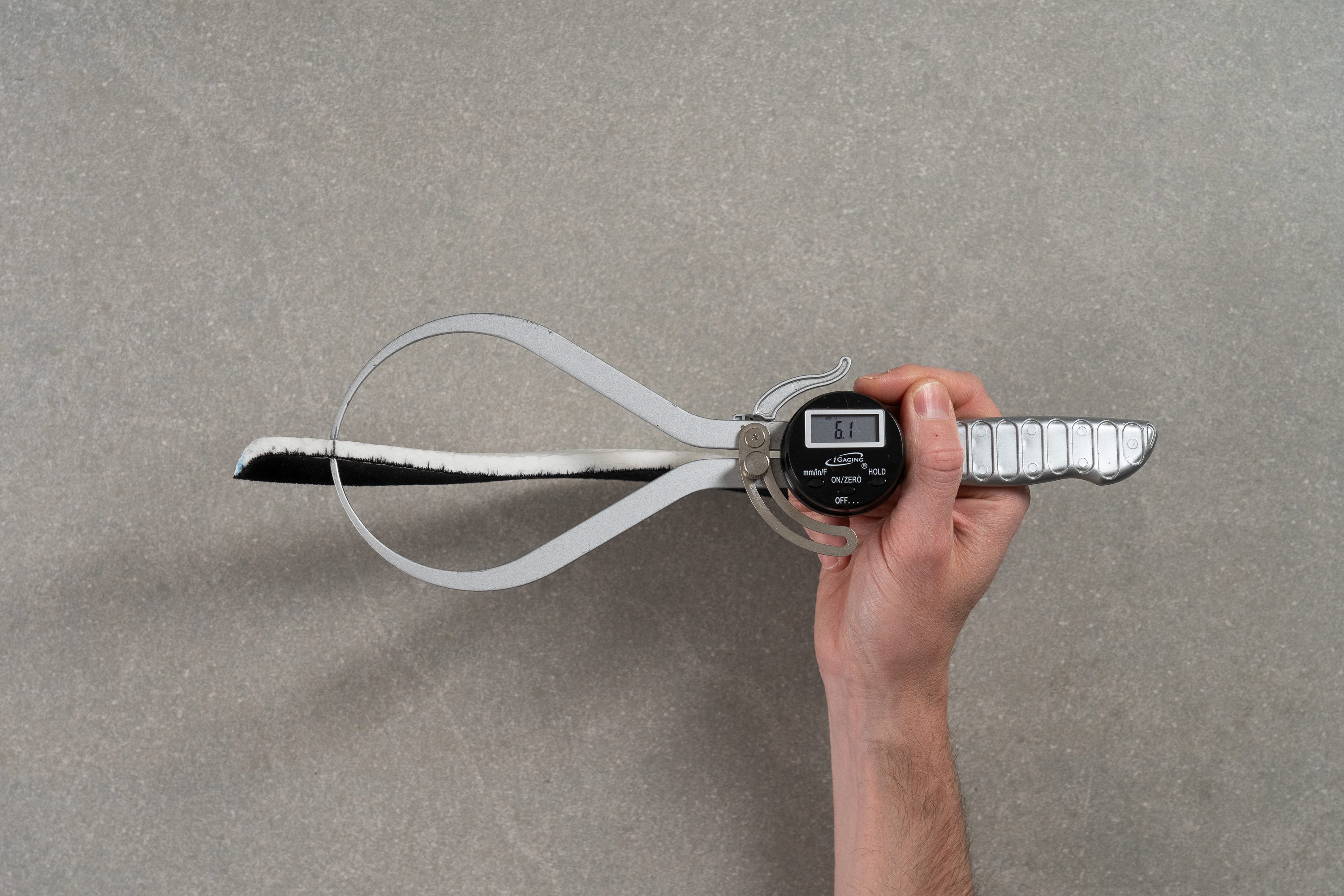
| Guide 18 | 6.1 mm |
| Media | 4.5 mm |
Plantilla extraíble
La plantilla FormFit se puede quitar sin problema, y como decíamos en el apartado de Drop, tiene puesto que el de estas zapatillas es de 8 mm.
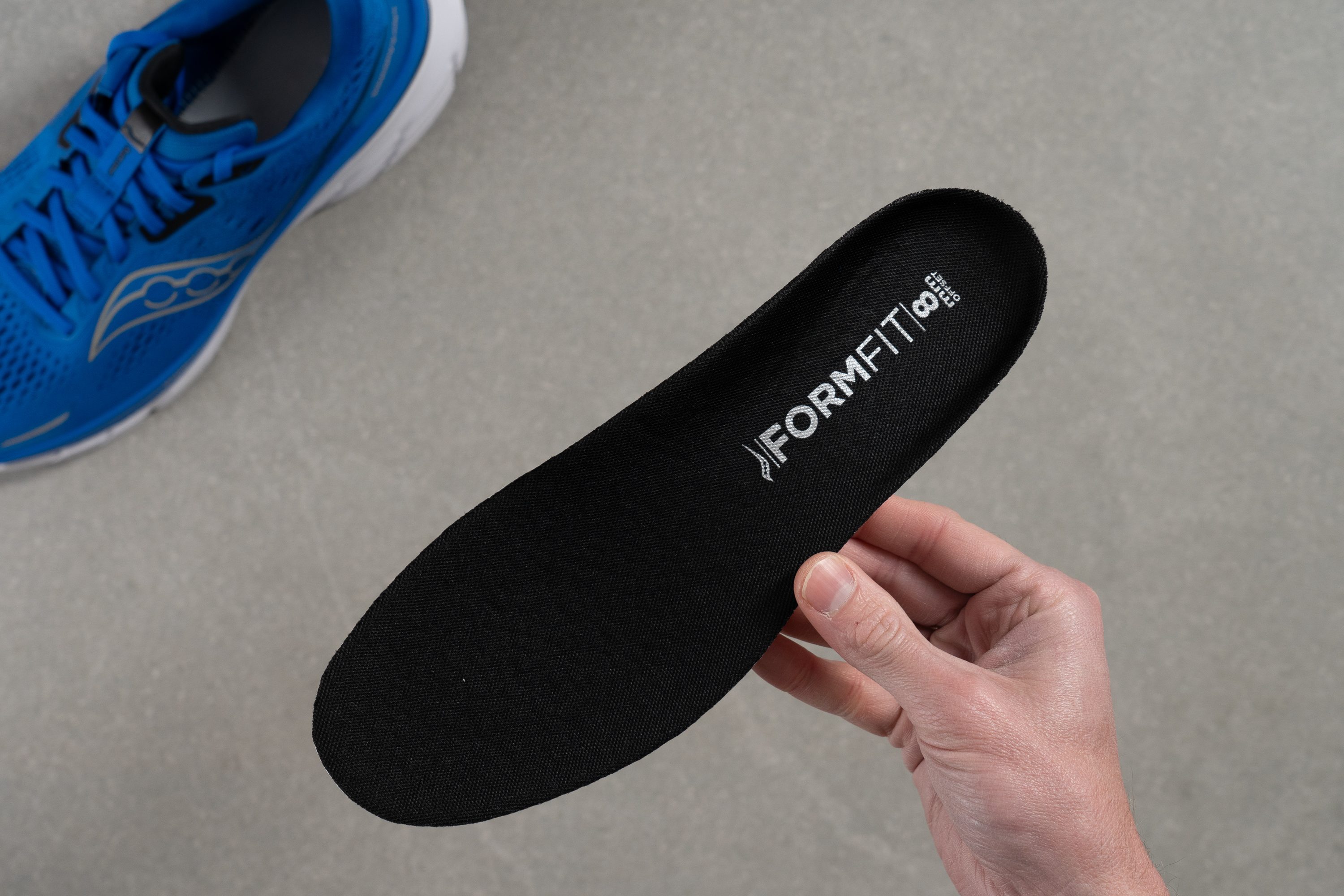
| Guide 18 | Sí |
Rigidez de la mediasuela en frío (%)
Después de pasarse 20 minutos en el congelador, la mediasuela de las Guide 18 se volvió solo un 8 % más rígida, demostrando su capacidad para mantener la consistencia cuando bajan las temperaturas.
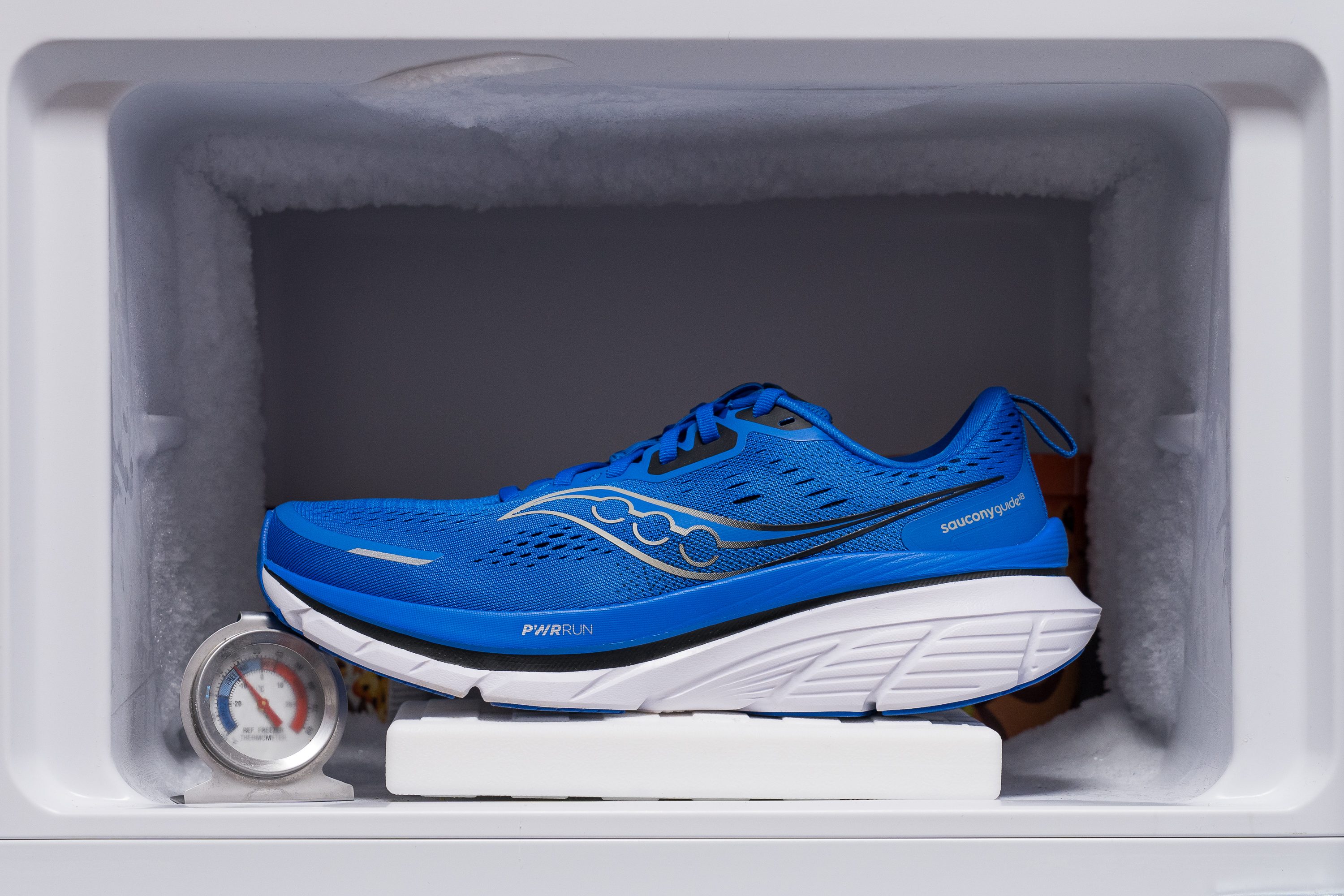
| Guide 18 | 8% |
| Media | 25% |
Elementos reflectantes
Las Saucony Guide 18 brillan las mires por donde las mires, aunque estos elementos reflectantes podrían ser más grandes para mejorar la visibilidad.
Es una mejora muy importante para los corredores que salen de noche, y más en invierno.
| Guide 18 | Sí |
Acolchado de la lengüeta
La lengüeta tiene un lazo que se encarga de que no se mueva de su sitio, y además también lo puedes usar de tirador. Otra cosa que nos gustó fue su simple pero eficaz cadena de ojales, que está reforzada con varias piezas de TPU que mejoran la durabilidad.
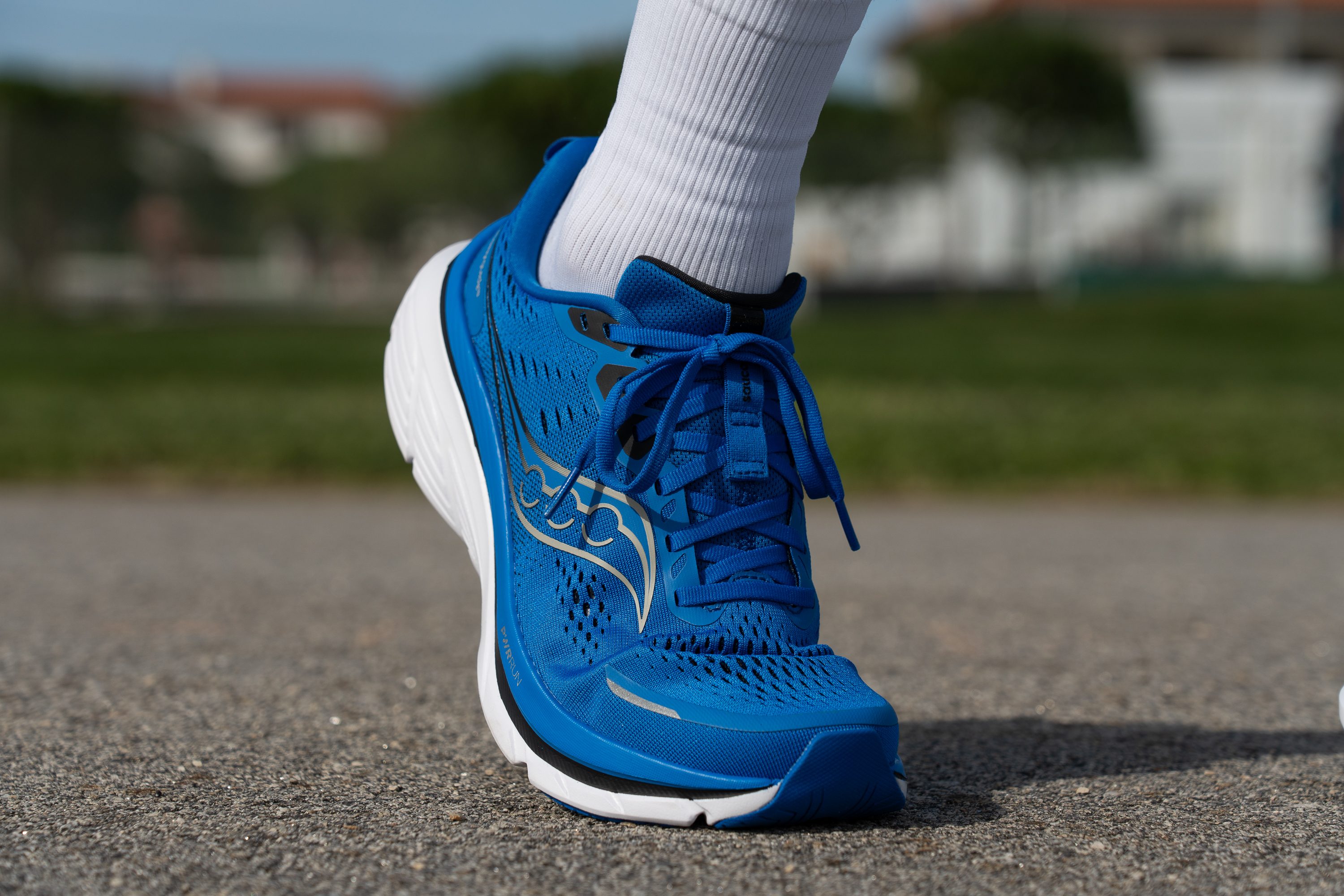
Con 4,1 mm, la lengüeta no es demasiado gruesa, pero creemos que la marca encontró un punto ideal entre comodidad y ahorrar peso. Personalmente, nosotros nunca sentimos que nos faltase acolchado, y toda reducción de volumen innecesario siempre es bienvenida.
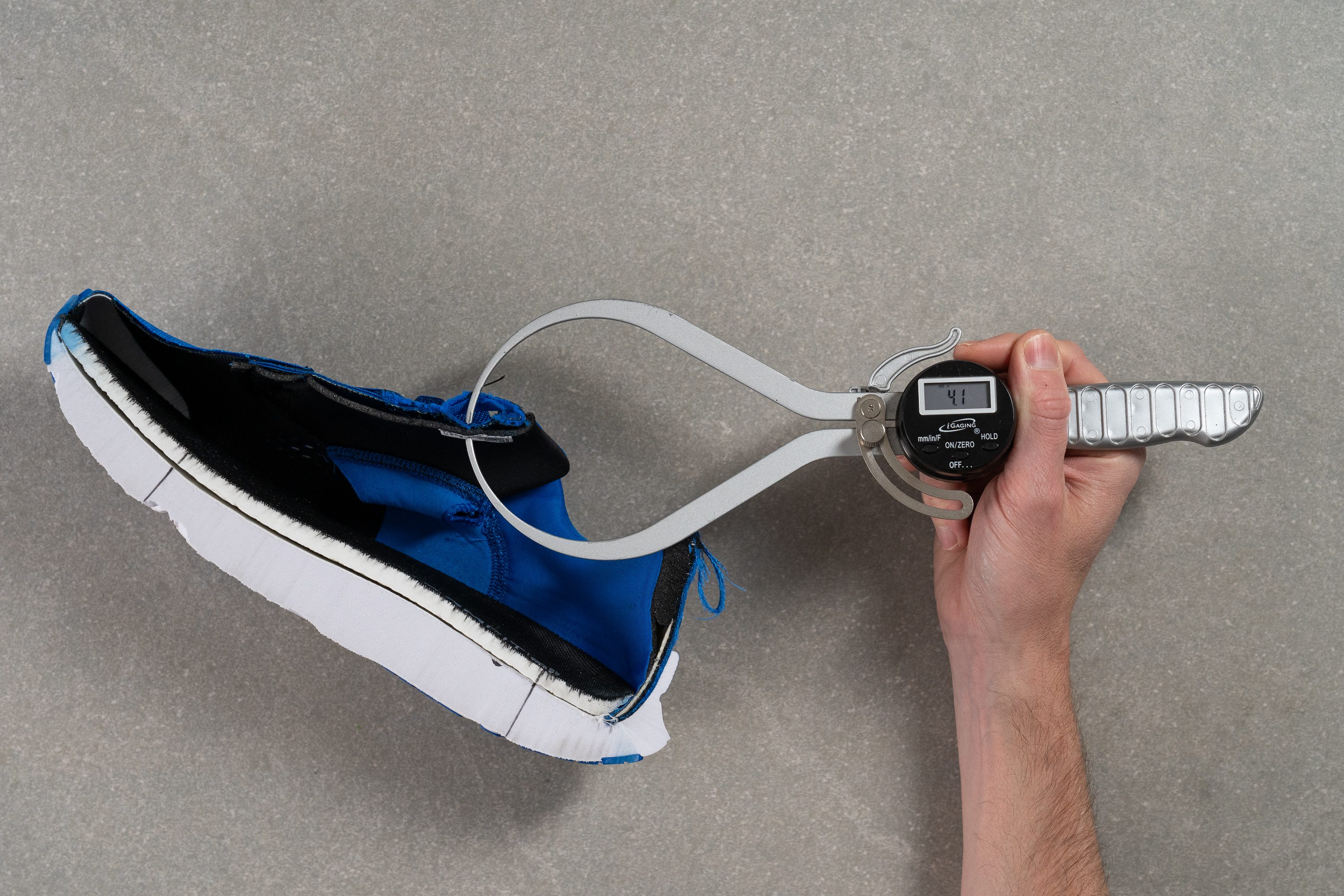
| Guide 18 | 4.1 mm |
| Media | 5.8 mm |
Lengüeta: tipo de refuerzo
Estamos encantados de poder decirte que la lengüeta de estas zapatillas está semi-reforzada, que es algo que muchas veces se pasa por alto en las zapatillas de running de gama media.

| Guide 18 | Ambos lados (semi) |
Tirador del talón
Tienen un tirador en el talón, sí, pero la verdad es que no parece muy duradero... por si acaso, tú tira de él con cuidadito.
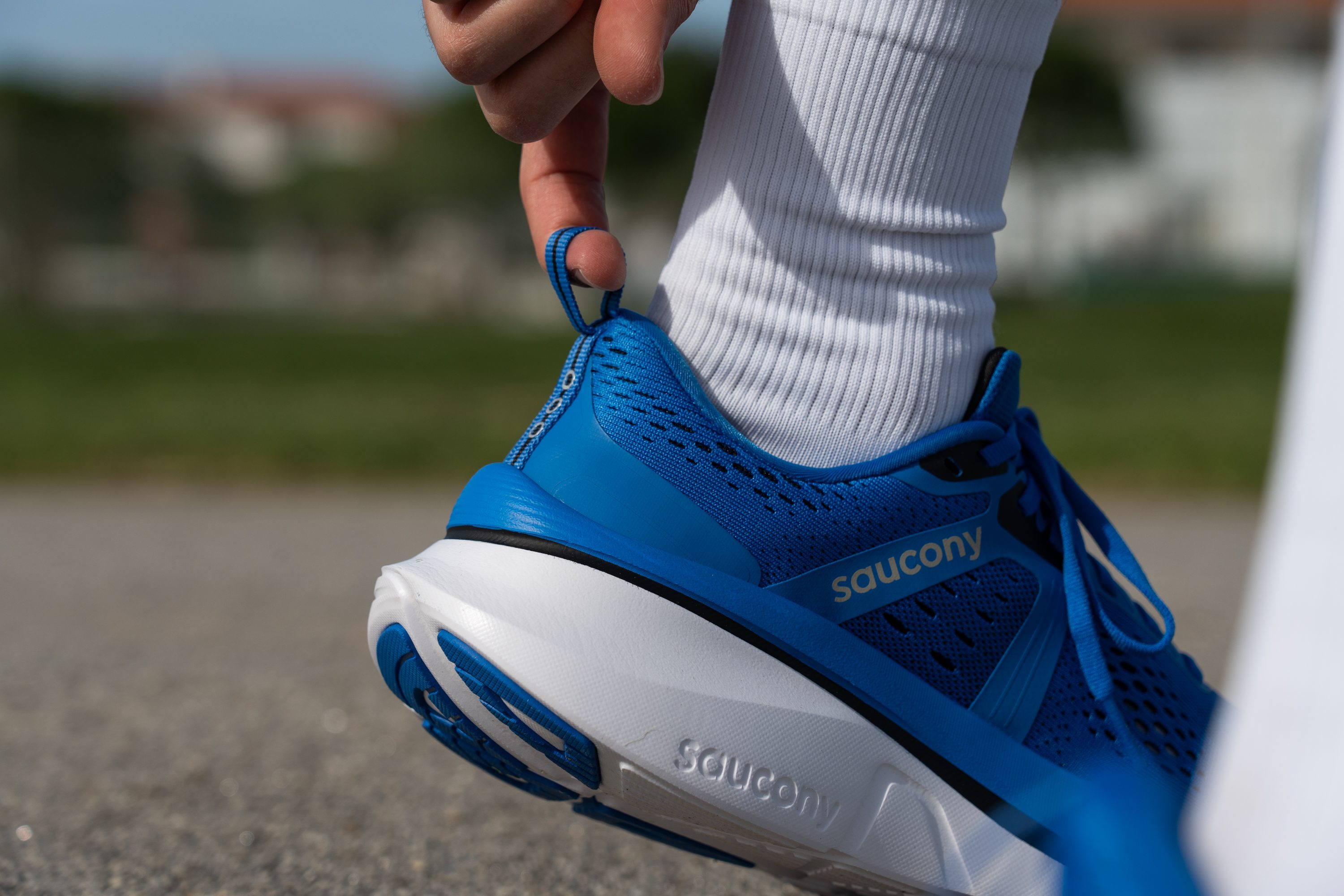
| Guide 18 | Tirador circular |

